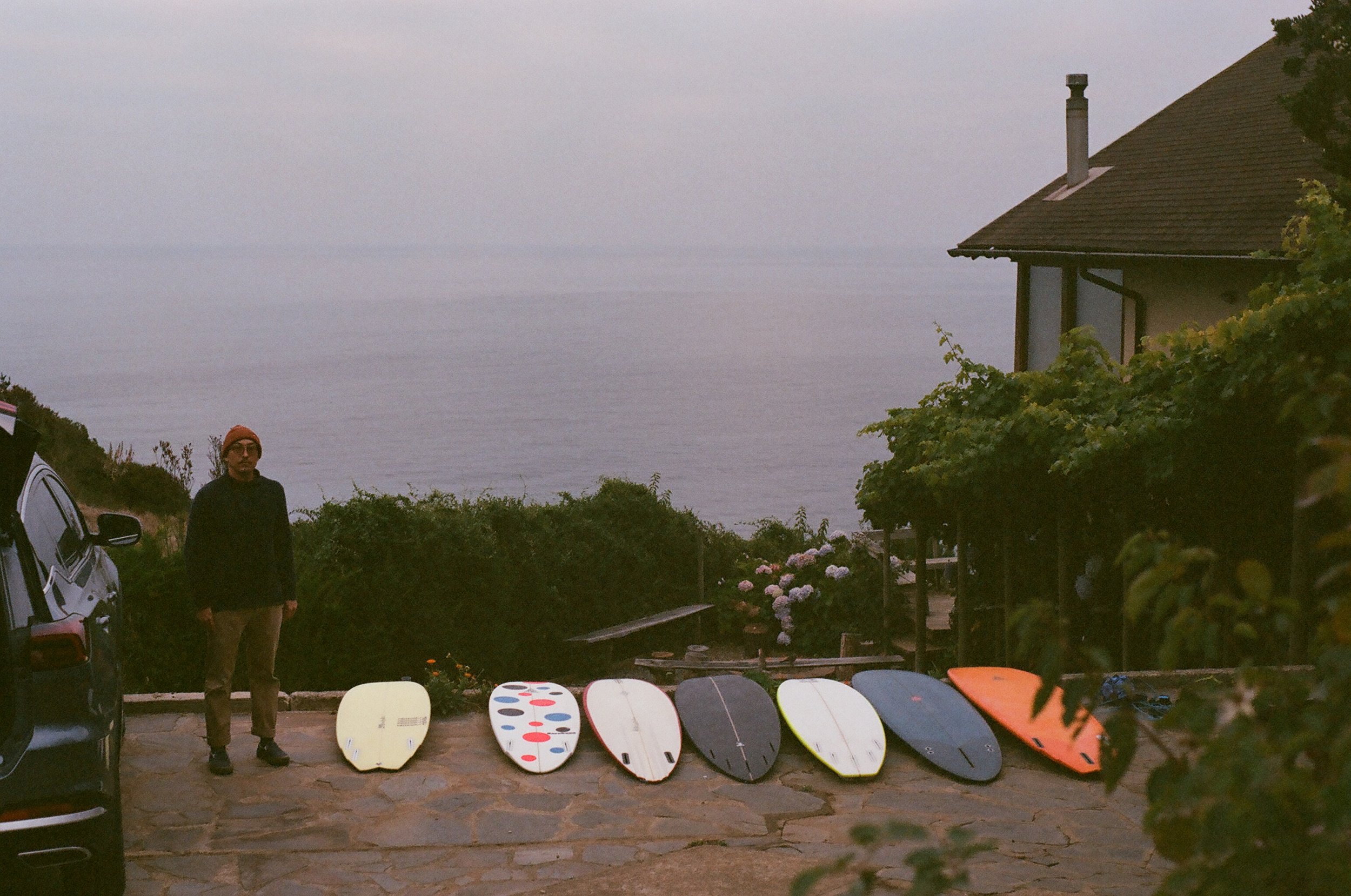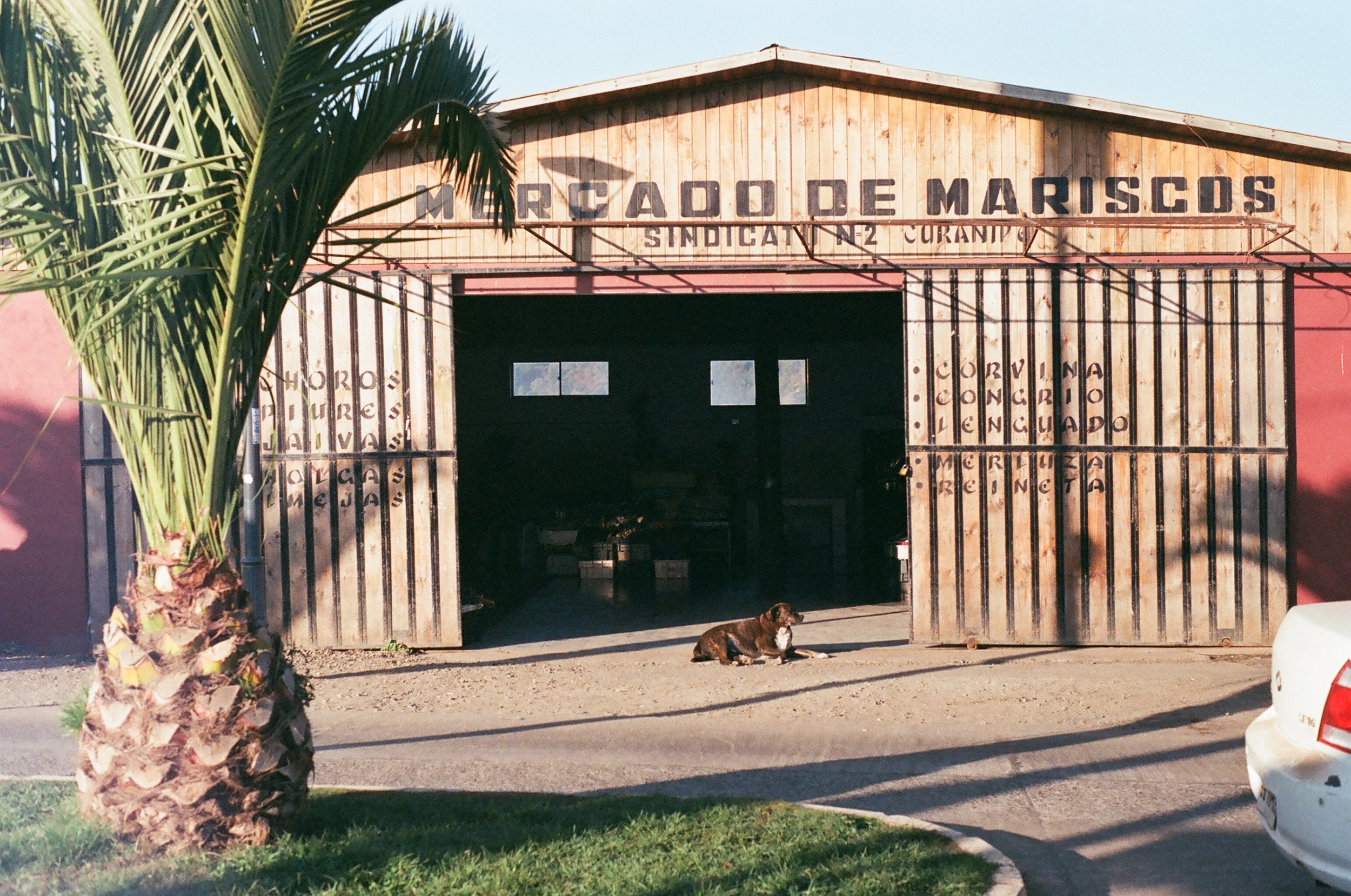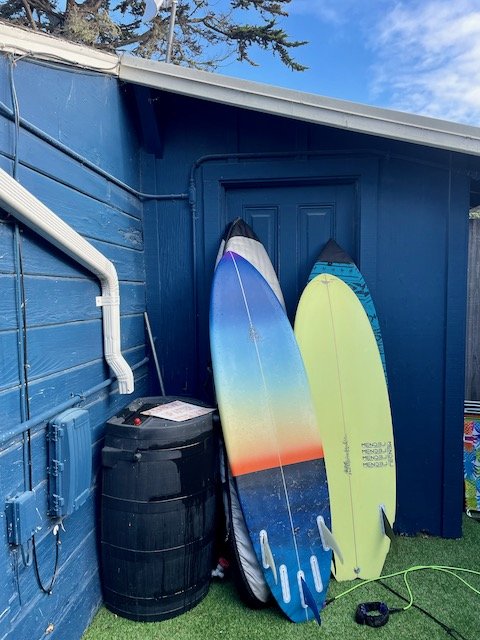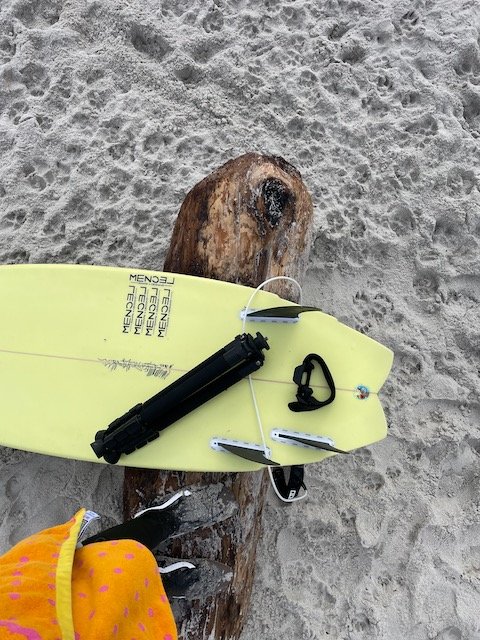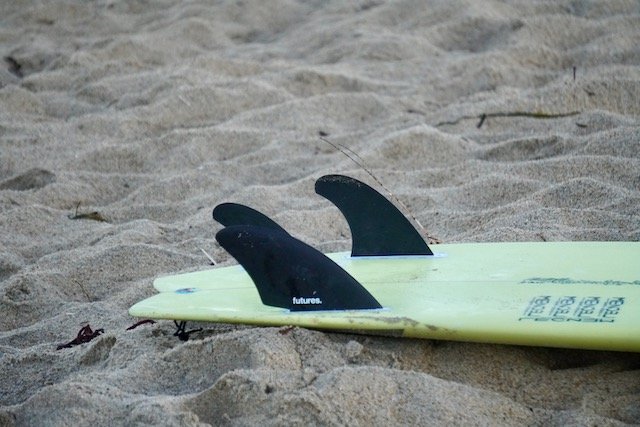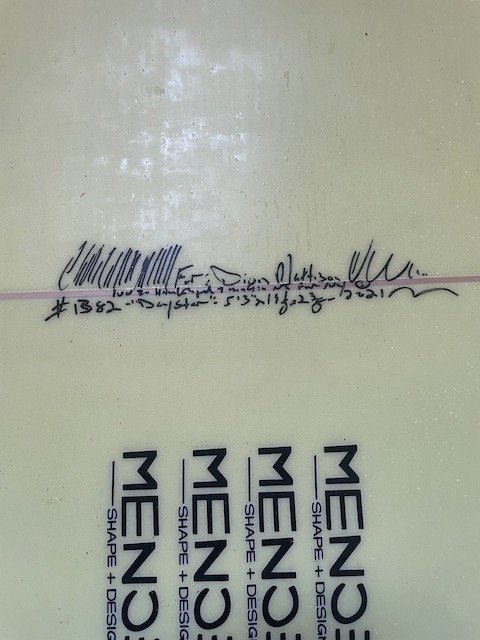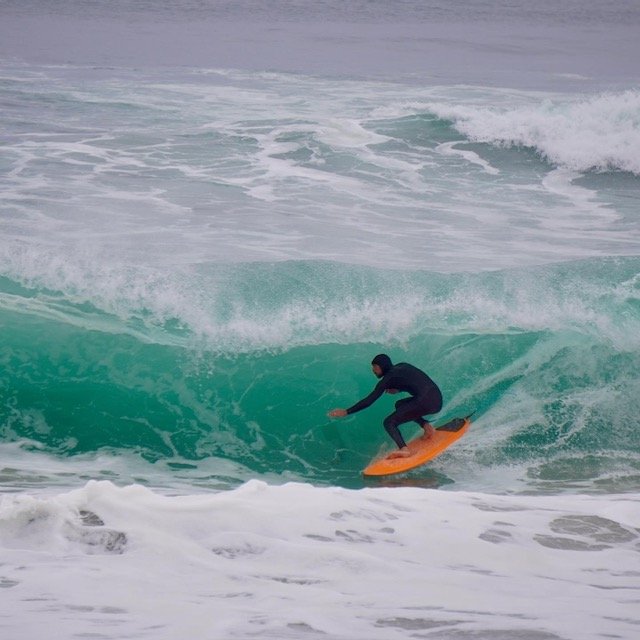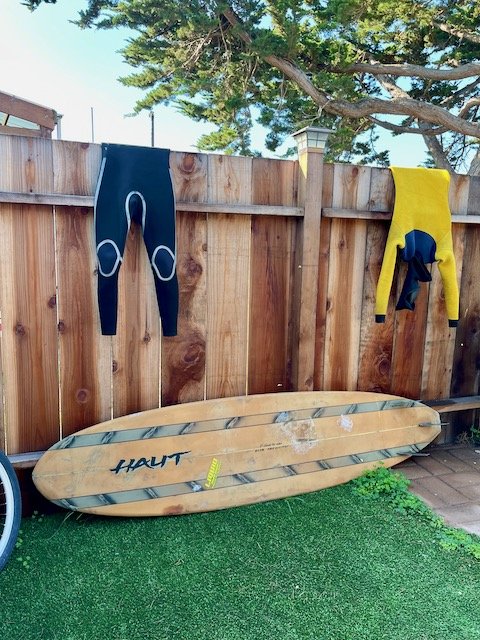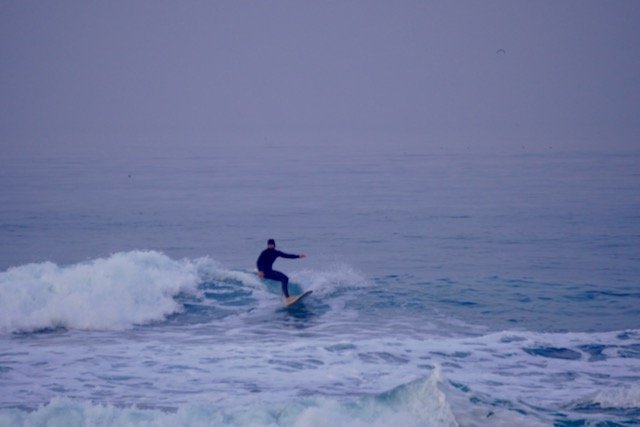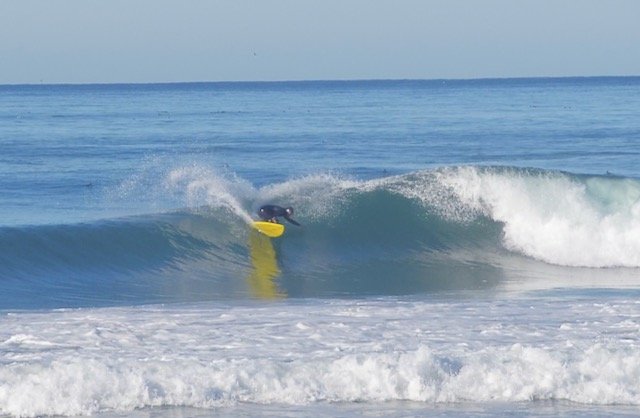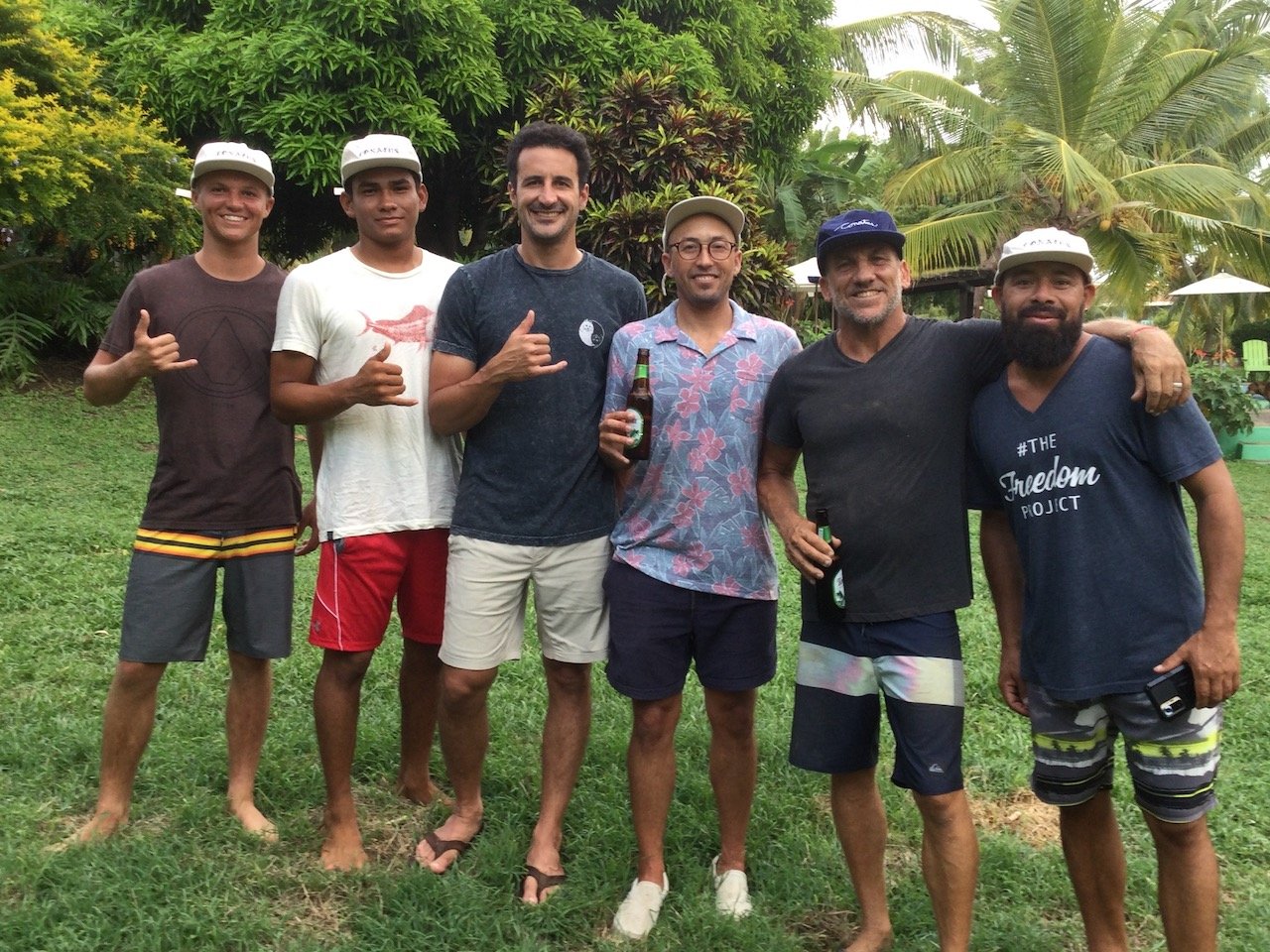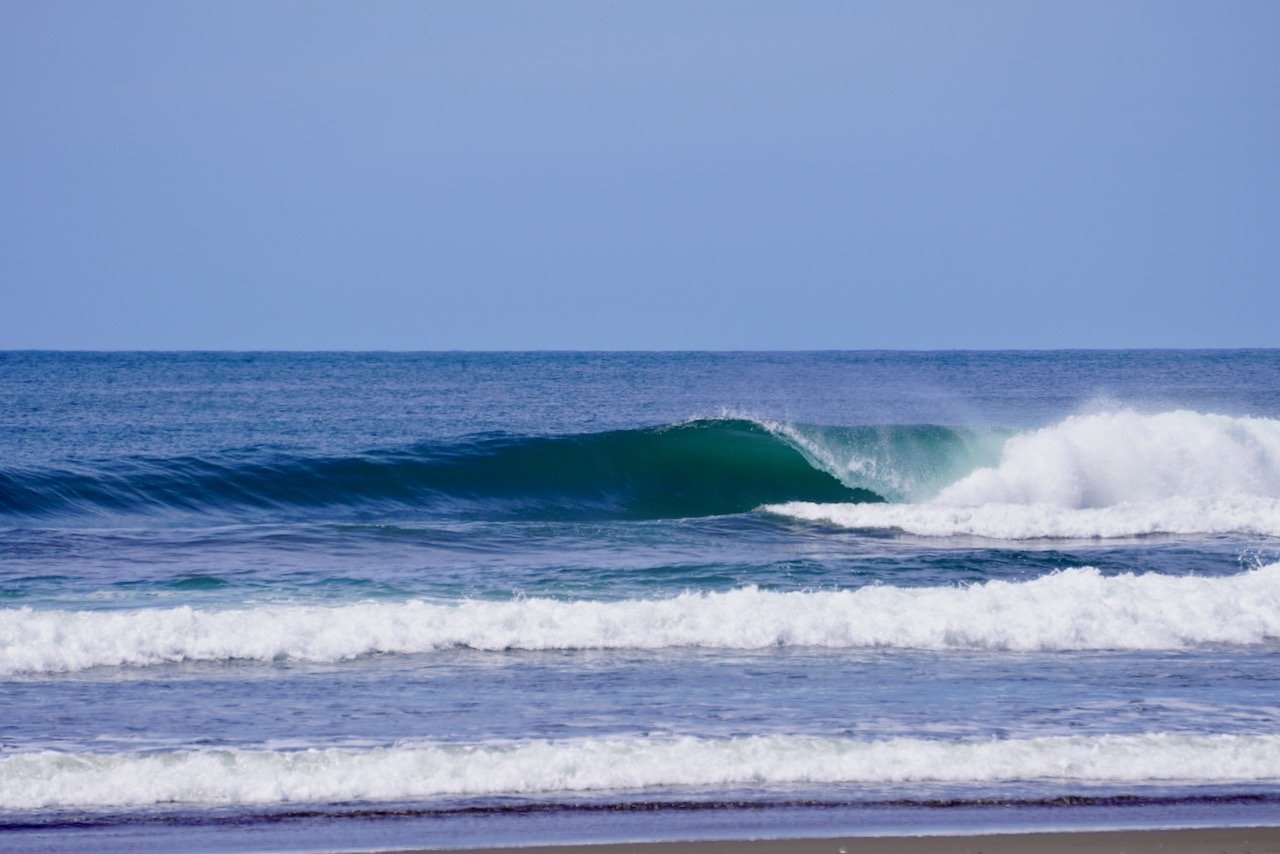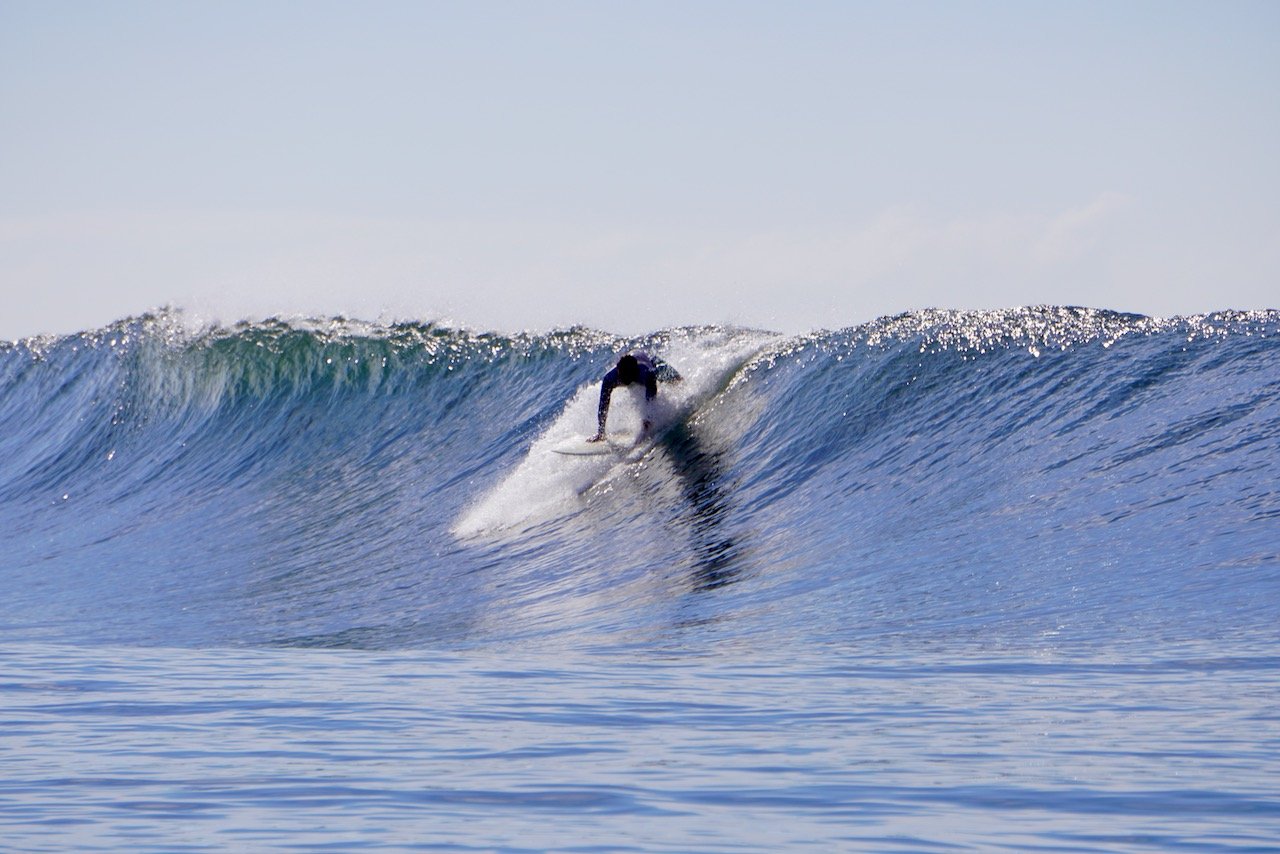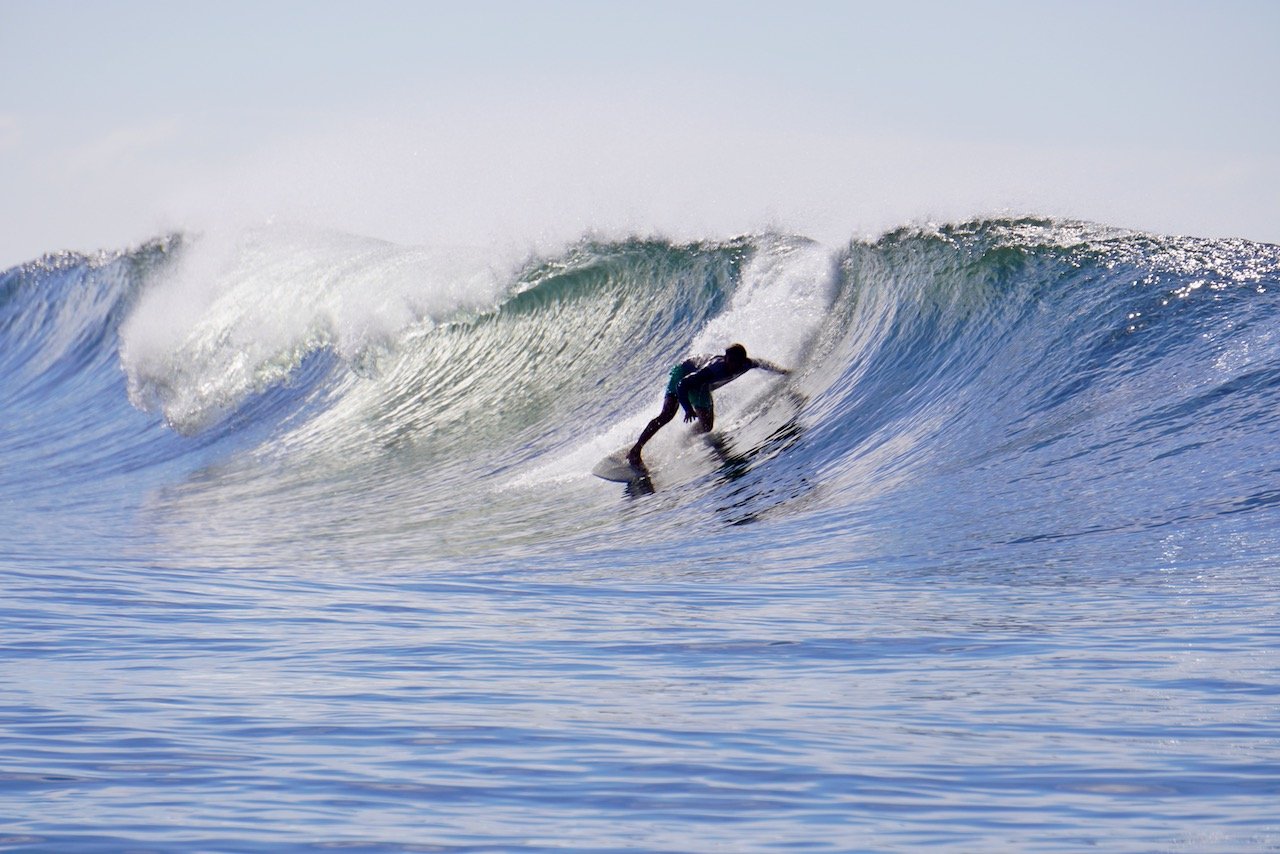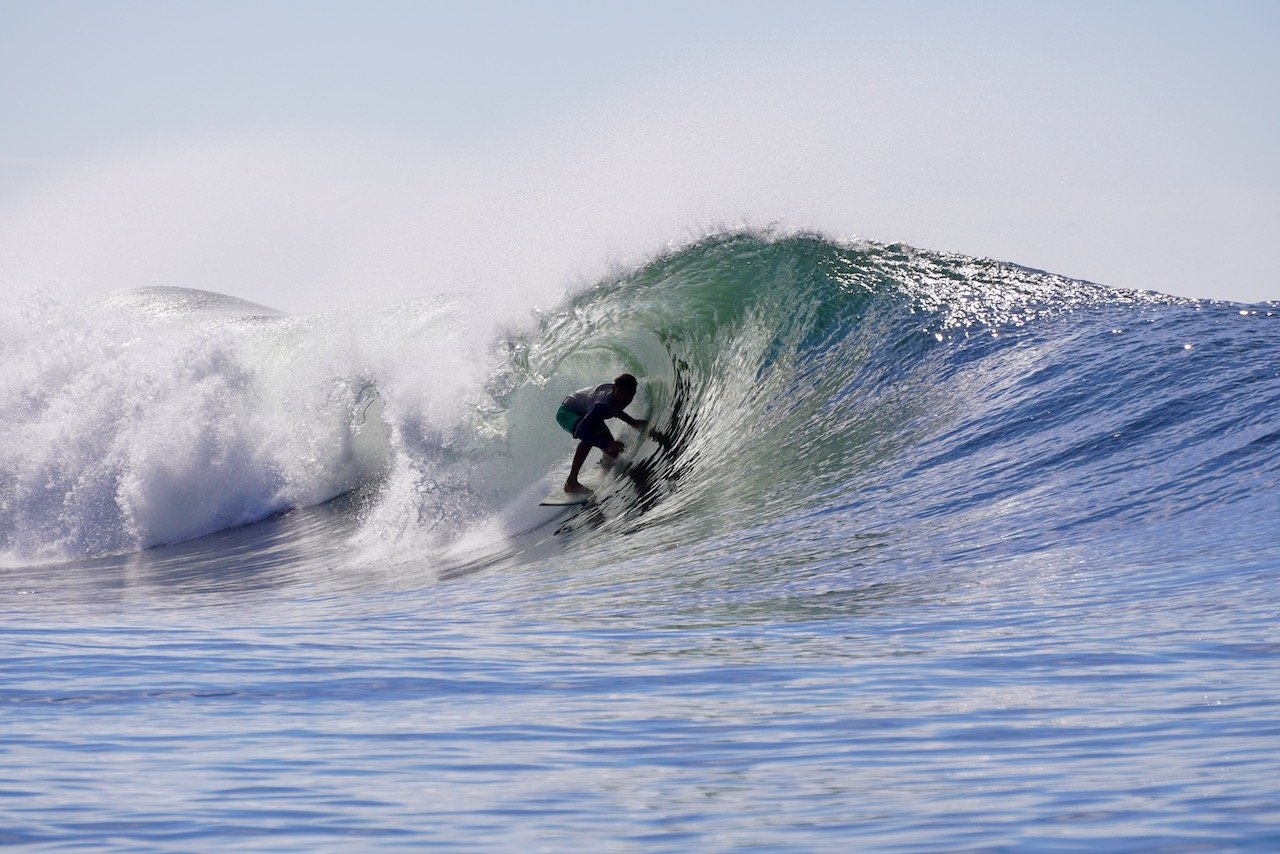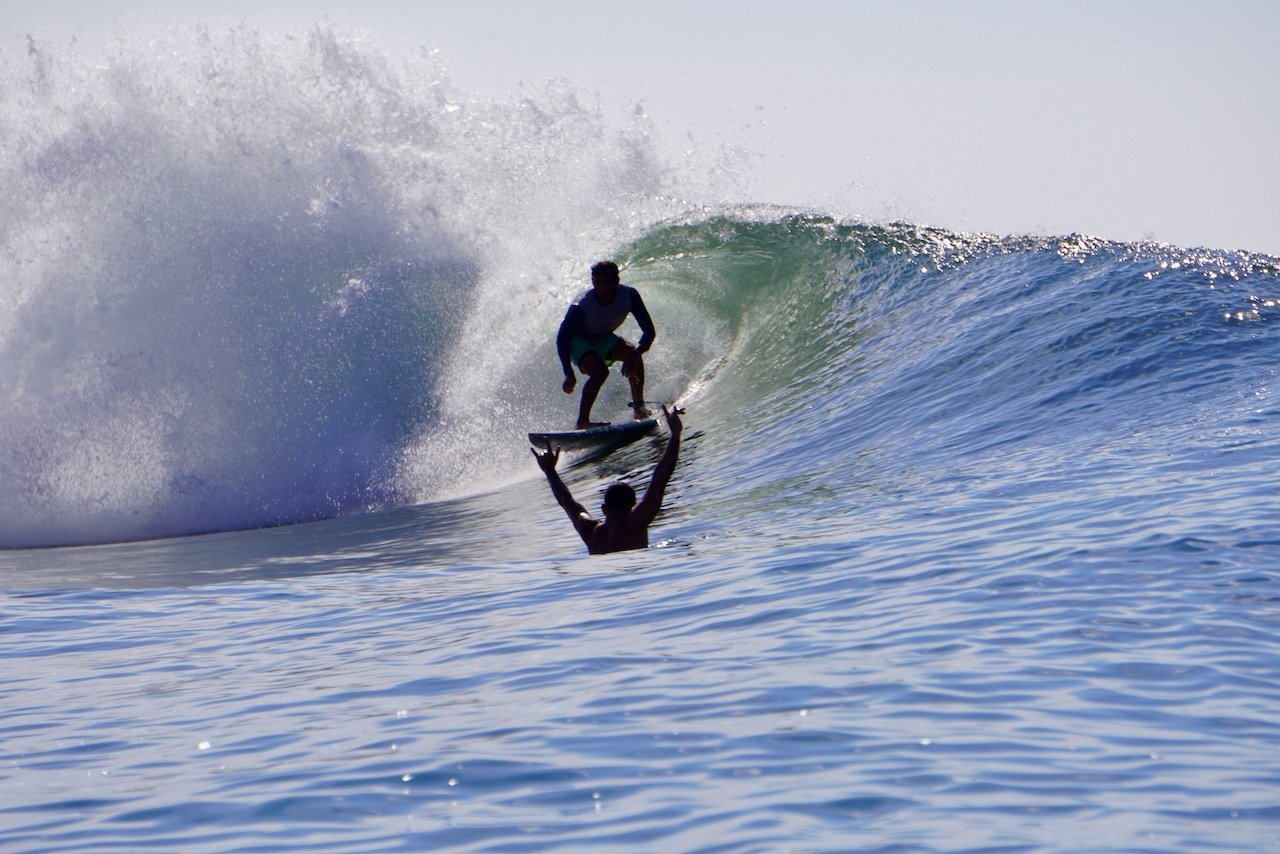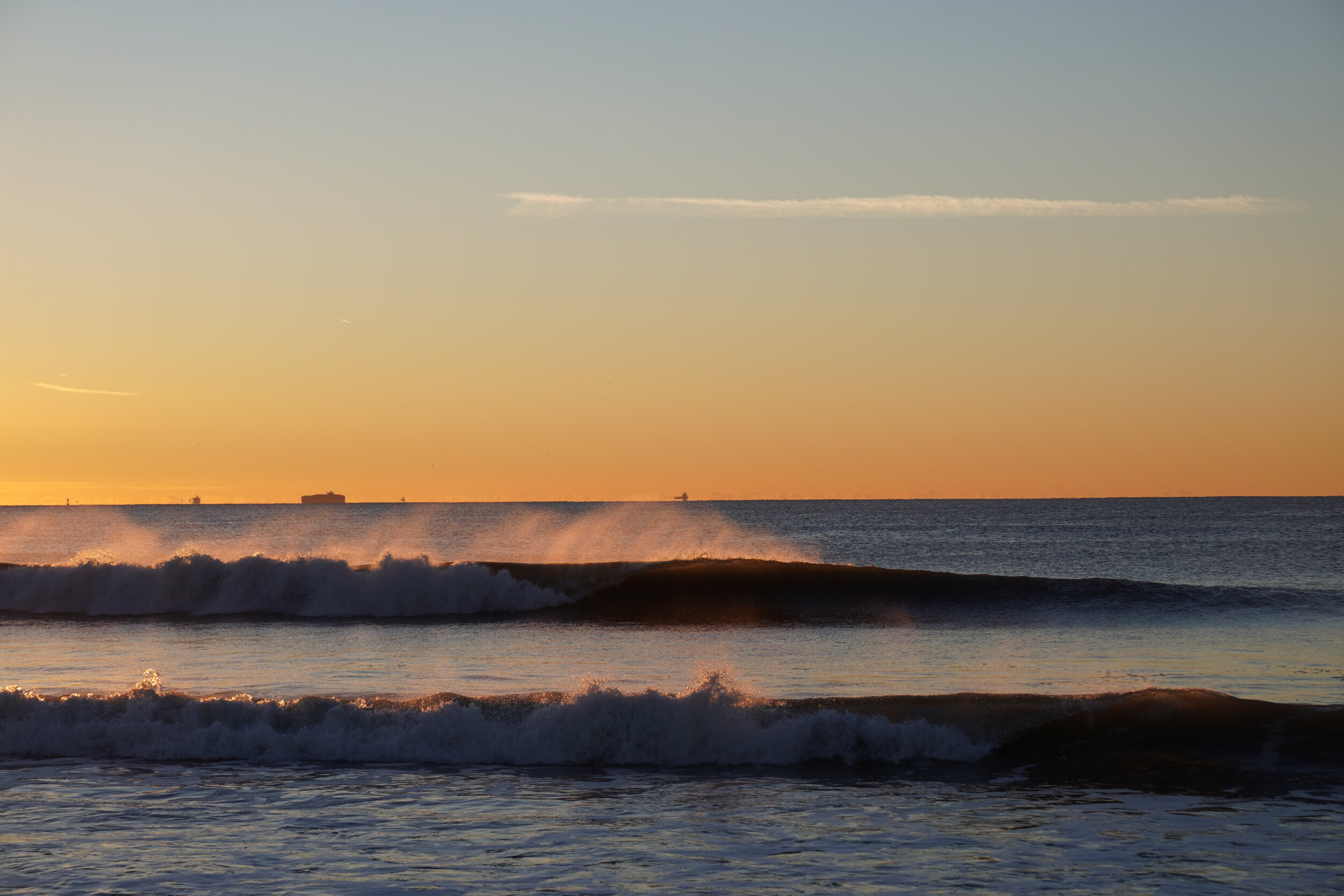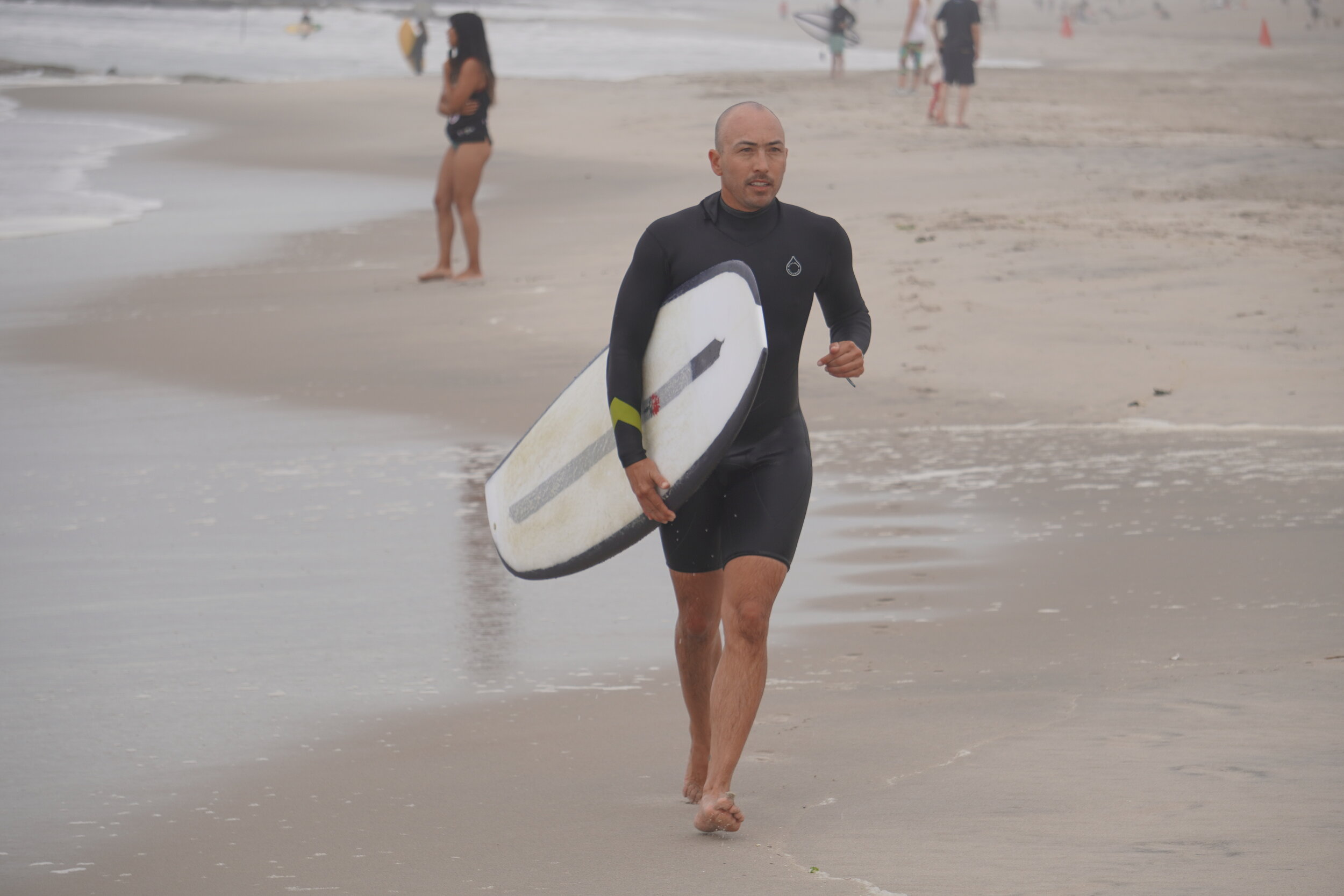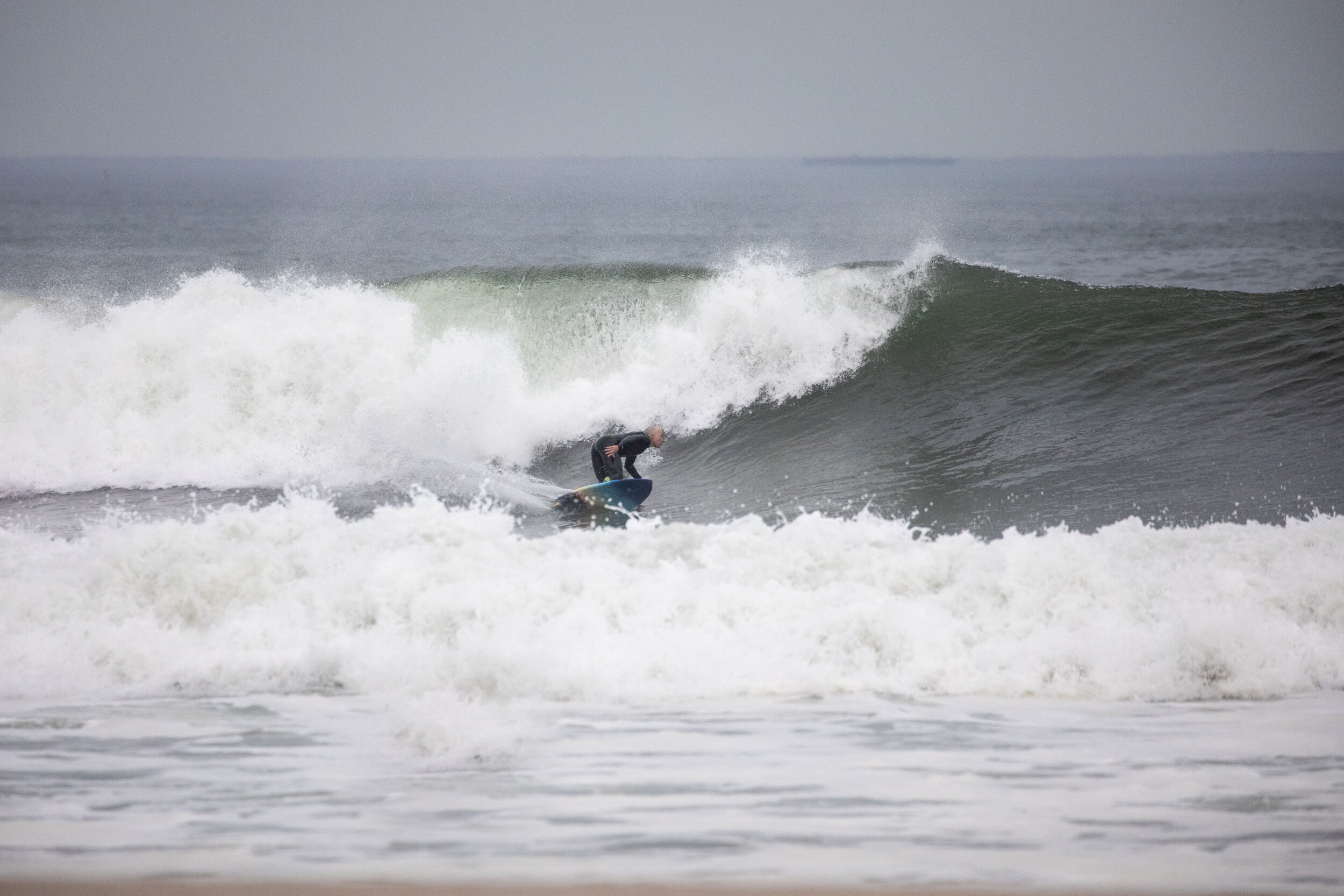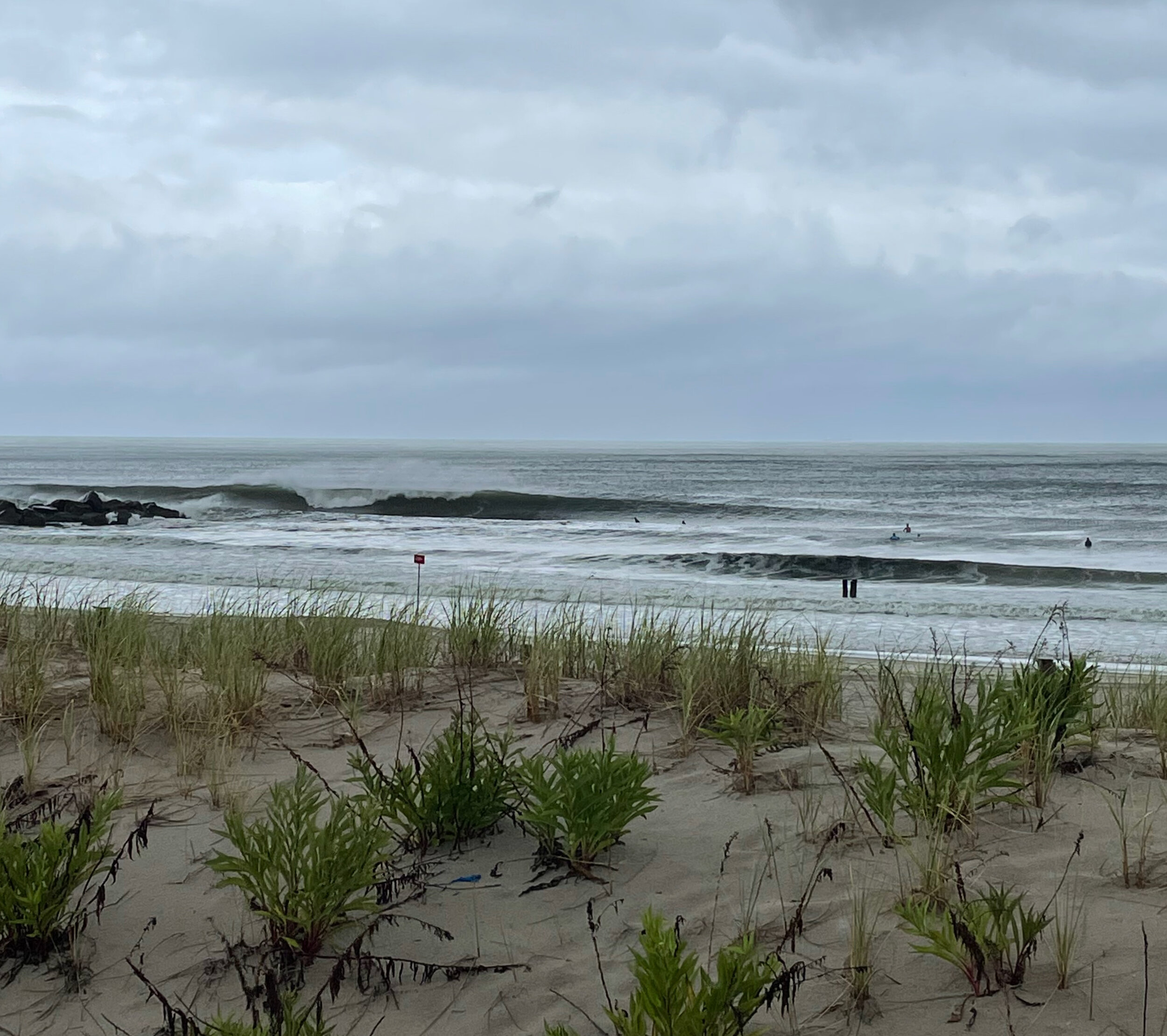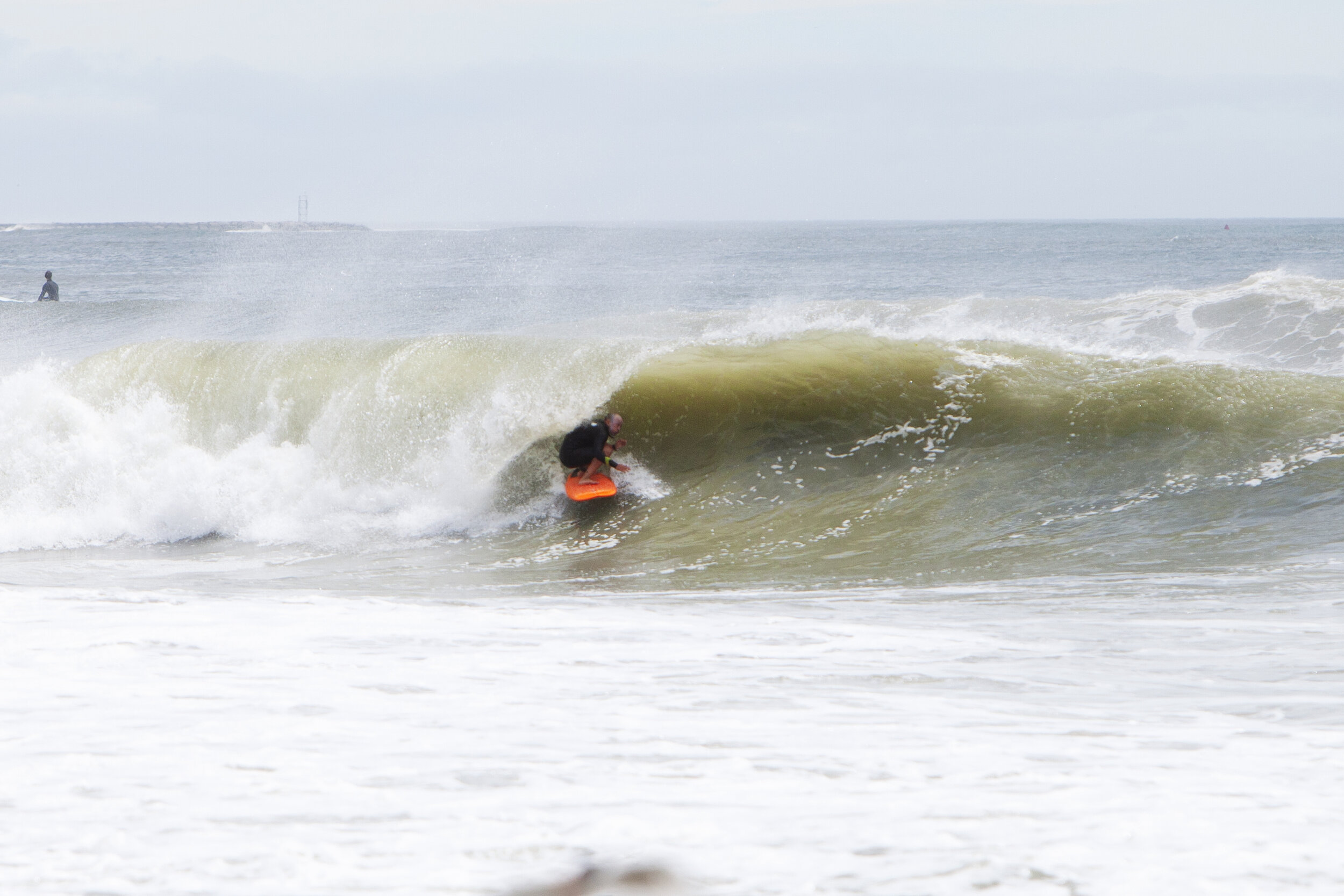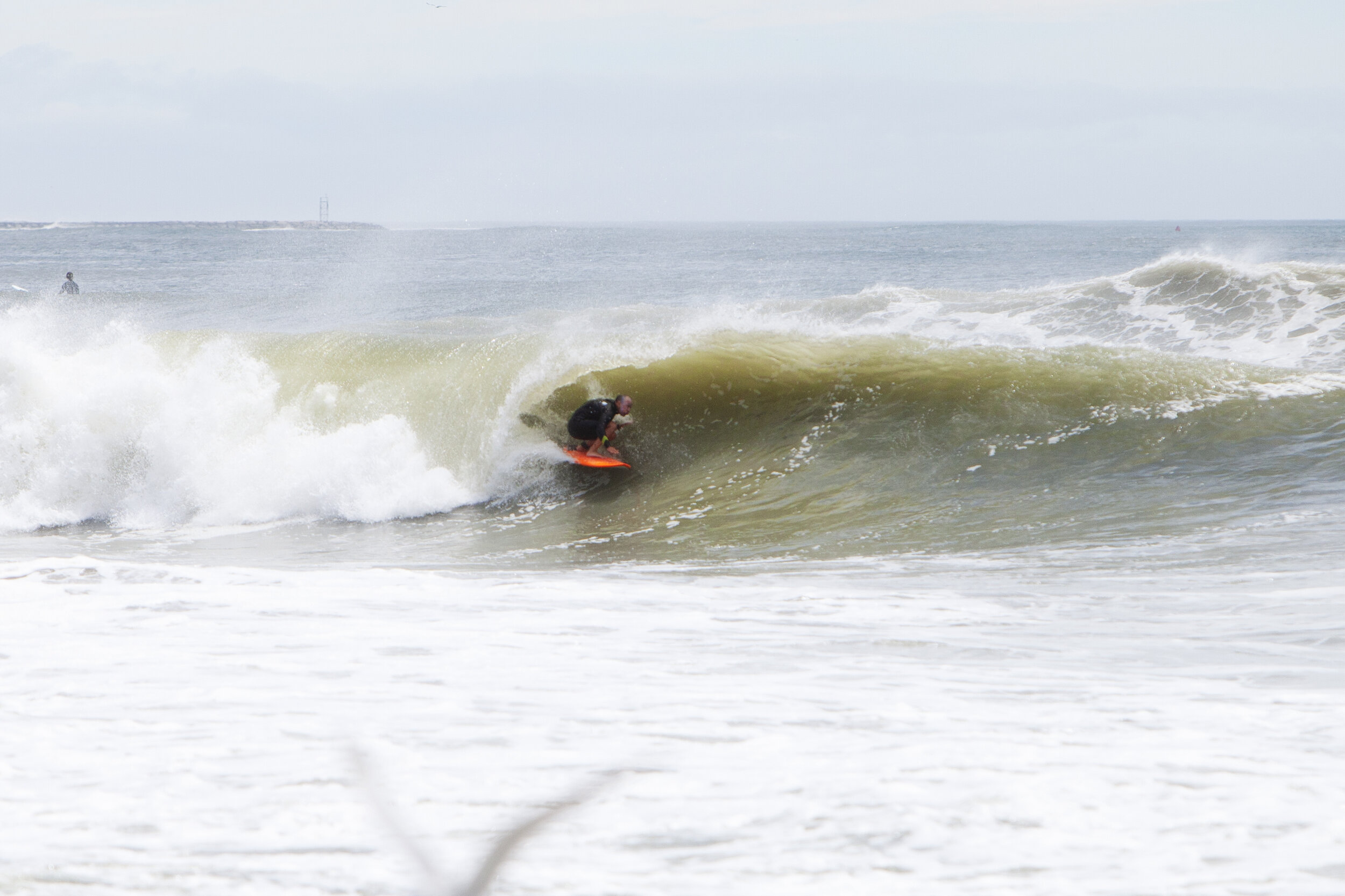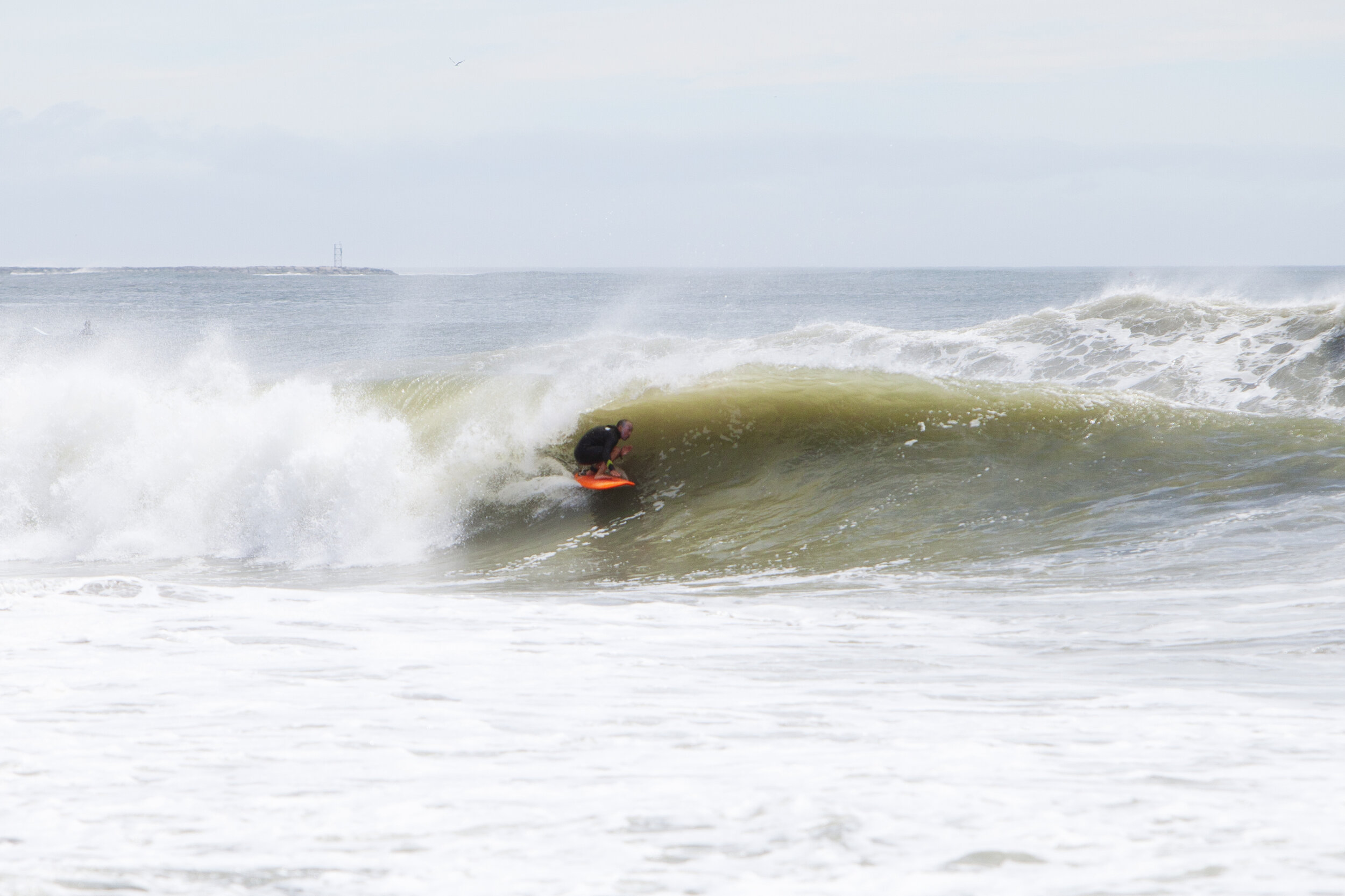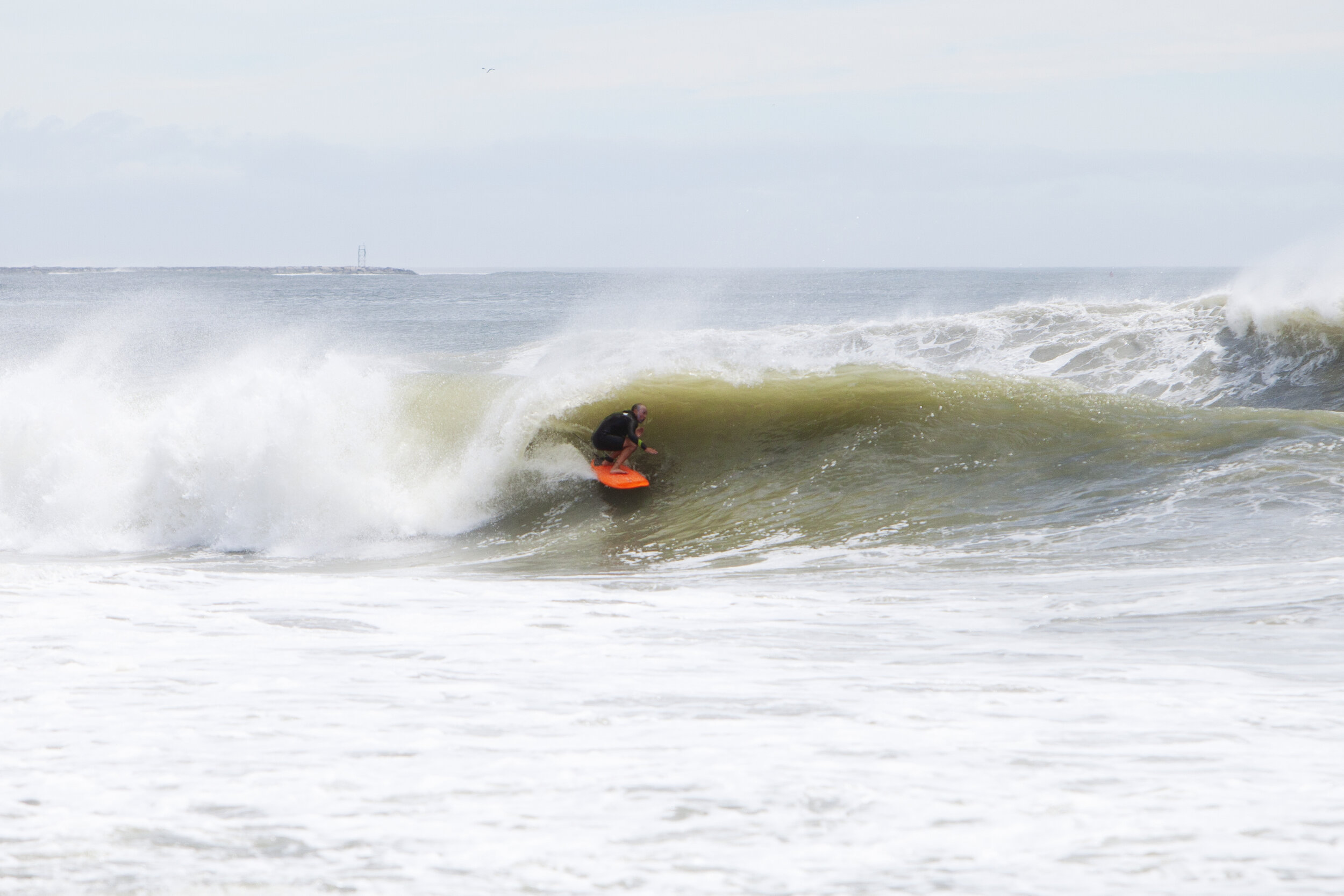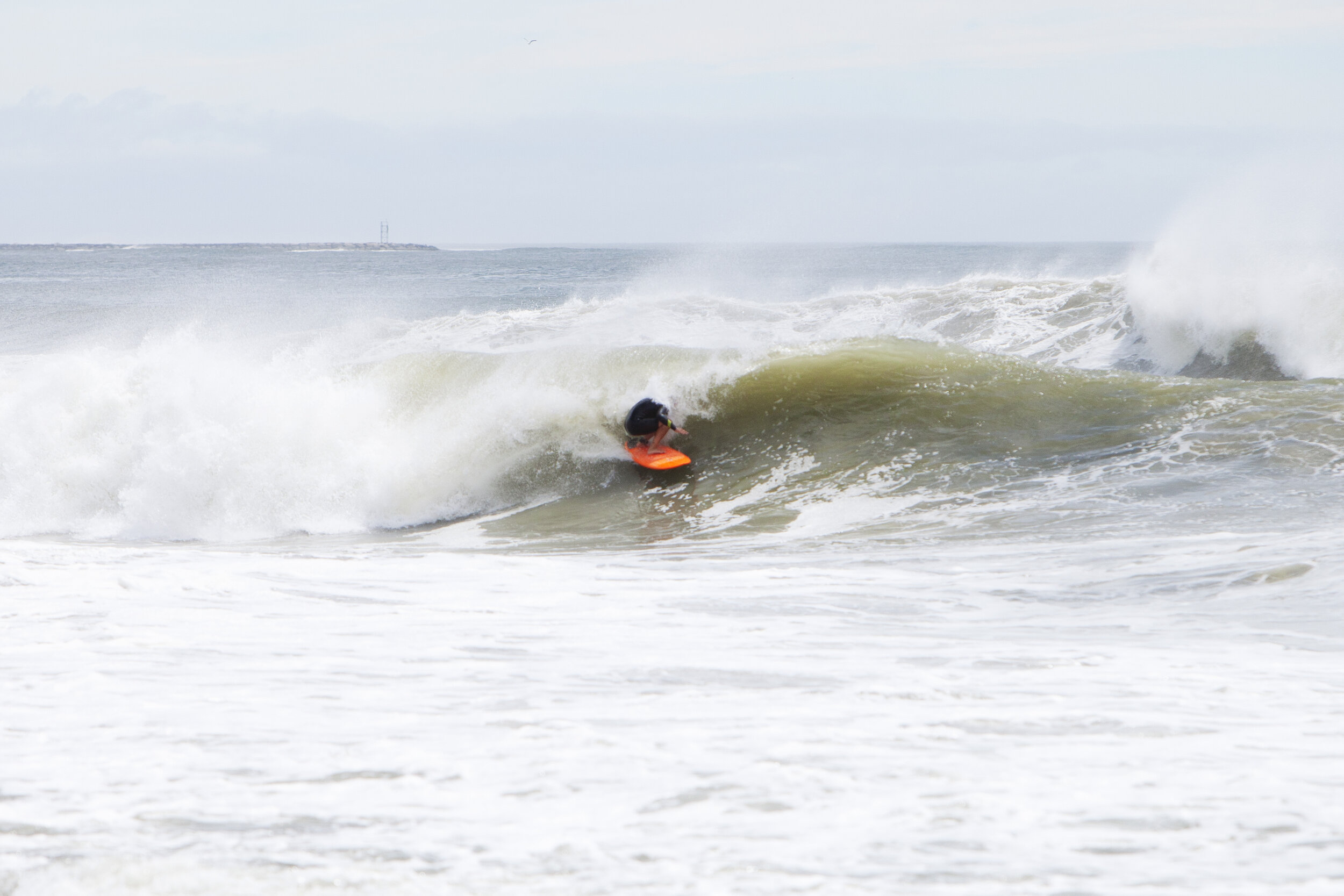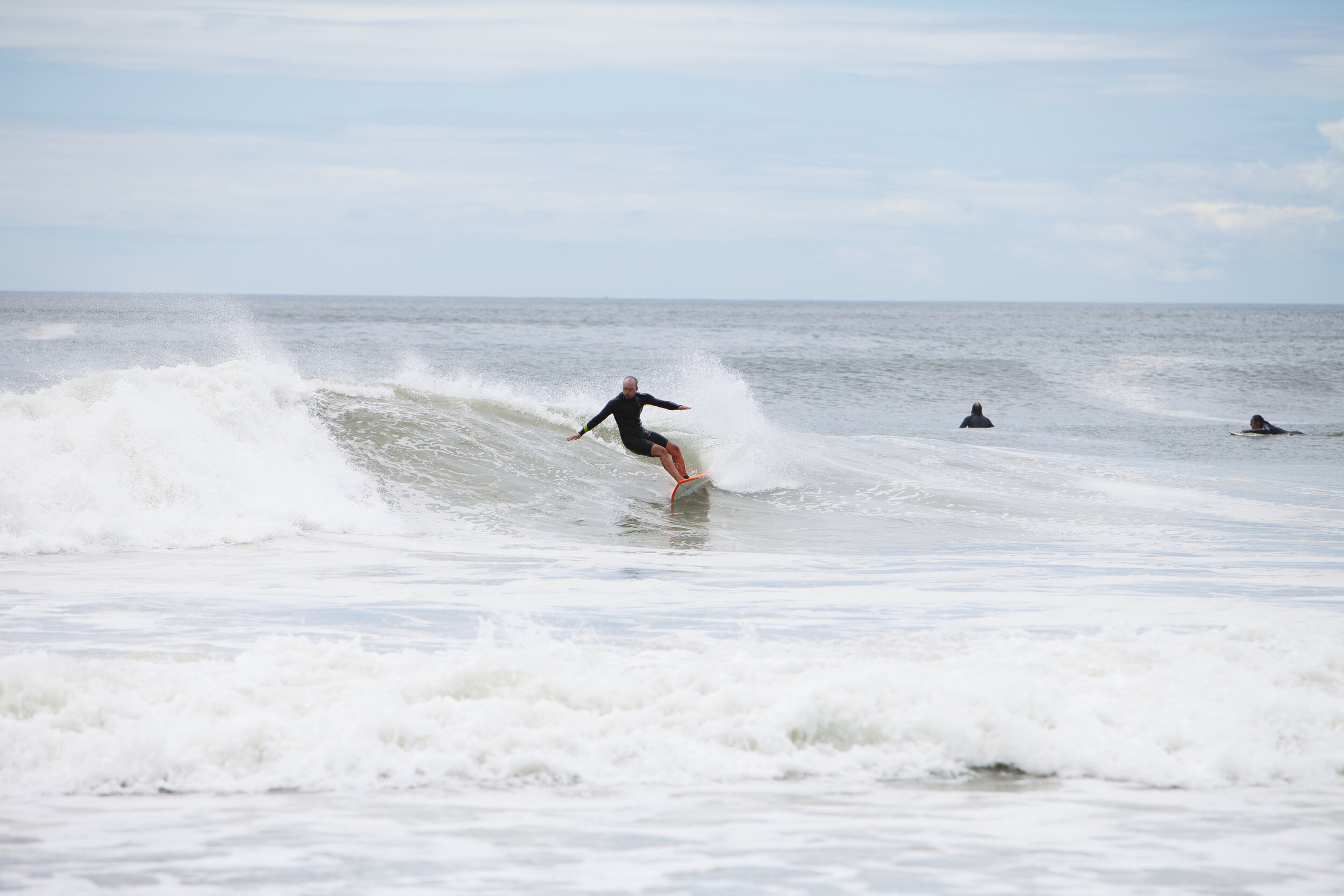After seeing Volcom’s Psychic Migrations (2020) I was particularly intrigued by the spots where Ryan Burch is riding the self-shaped rainbow fish. Then I serendipitously met Jesse Faen in NY. Jesse owns the house where Ryan et. al. stayed while they were filming that part. I vowed that I’d one day rent his house from him and surf those spots. When Covid restrictions started lightening up in the fall of 2021 I started planning tons of travel. Most of it was spent going to Costa Rica to run retreats and plan things for the property with my brother, but I wanted to throw something else in the mix. April was ear marked because a long time client, Nelson Hume, had requested to do a trip in that time frame. I didn’t want to run a 4th retreat in CR, so I was like, “What about Chile Nels?” His response was overwhelmingly affirmative. I started looking into flights and WhatsApping Jesse about availability on the house. Allie Marsiello had also requested a trip in April, so I texted her next, “Chile?” Her response: “Yes! and Cheyne is jumping up and down saying, ‘Take me too!’” Everything was starting to green light. I mentioned the trip in one newsletter and our fifth trip member, Bonnie Stamper, got on board. I capped us at 5, since it was a new-to-me zone and I knew the waves were going to be a bit on the heavy side. We all booked our flights. I secured the house with Jesse. Then it took almost a full two months to clear all the Covid regulations for entry into Chile (there were a ton, but I think they’ve maybe chilled out a little now). We all arrived on April 15th. Nelson and Bonnie stayed until the 21st, and Allie, Cheyne, and I stayed until May 1. We surfed a bunch of different spots. A huge storm came just after Nelson and Bonnie left and changed all the sand around, so I’d say the best surf was the first half of the trip. We had one negative interaction with an American, but beyond that, it was all shakas and smiles and good times. No issues with the locals, who were just so friendly in the water and out. The waves were heavy and challenging for Allie, Bonnie, and Nelson, which I think was overall great for their surfing. It’s always good to push yourself! It was a huge pleasure going on a surf trip with Cheyne. Cheyne is our local ding repair guy here in Rockaway. He originally hails from Ventura, CA. He and I were tripping out on the Chile environment the whole time because it’s so much like home. Cheyne brought along his film camera and took some amazing shots that I’m going to share below with captions. He has his own website: www.cheynebluhm.com to see more of his excellent work from home and abroad.
CSC Surfboard Test and OG Grom Crew Reunion in CA Dec 2021
On Dec 2-15, 2021 I traveled to my home state of CA for a few reasons. One was to escape New York flatness. A second was to see my family and friends. I normally go back 1-2 times a year, but that had been stalled for obvious reasons. My trip to Nicaragua in November was my first air travel since the pandemic started, and it went pretty smoothly in terms of Covid protocols. This gave me the confidence to fly again. Without the PCR testing, a domestic flight seemed even easier. And it was. The third reason was that after years of building a business I finally have all these incredible boards. In fact one of the motivating factors in starting CSC was to figure out a way to make investments in surfboards into a research project and tax write off. That’s not the sole motivation of course. First and foremost I love watching people unlock their potential in the surf. But these things are interrelated. I realized that in order to unlock my own potential I needed to experiment with new boards and expand my quiver. If I don’t practice what I preach myself, then I truly am an ill-fated sophist.
On the trip to Nicaragua I brought an all twin fin quiver, but this time I wanted to mix it up even more. I knew I was additionally guaranteed all day long surf sessions in quality waves (winds in CA in December tend to be pretty darn favorable for all day surfing, and it’s also not too tidally fickle — you can find something that works on any tide). I couldn’t decide between a few different boards, and knowing that the pros travel with 6-12 boards, I googled, “What do the pros use to take their quivers on the world tour?” The search yielded the Dakine “Tour Regulator” board bag, which holds up to 8 boards. I also found a few options by Destination Surf and Creatures of Leisure. The former looked like overkill and the latter was sold out. Evo.com had a sale on the Dakine, so I went for it, and packed 7 boards, 3 wetsuits, 1 pair of boots, 1 squid lid, two towels, a yoga mat, a small Pelican case filled with useful surf tools (leash strings, fin keys, a flat head screw driver), an empty Ikea bag for lugging camera gear and water, a Pilgrim Surf + Supply wet/dry bag for stanky suits, and 3 leashes. Most of the boards were in their own individual sock or bag, and I used the wetsuits to pad the tails and noses. I usually never use packing material that does not also double as a useful surf product when I’m on the road. My theory is that if the Airlines truly want to crush your boards there is no kind of packing that can withstand that. There is bad packing, however, and that is leaving boards loose in the bag and not taking any precautions to pad their more sensitive areas. I packed an entirely separate suit case for fins, wax, and camera gear. The bag was still 100 lbs when I got to the counter. It’s a good thing my roundtrip fare was $200! They didn’t count boards, just charged me $200 for an overweight bag. I always use carts in the airport, which is actually why I opt out of the wheeled bags. I find they’re way more expensive and still more difficult to lug than just plopping the thing on a cart. Said plopping is not necessarily a piece of cake with the shitty carts you pay for in America. People definitely look at me like I’m a complete lunatic when I’m wheeling around the coffin bag, taking it off the cart to get into the air train or elevator, and then putting it back on again. And it turns out it got me into a spot of bother at the rental car center in SFO. Fox (never rent from them) is now off site and their shuttle drivers refused to accommodate my boards. After 4 tries and one hour wasted I walked upstairs to Thrifty and rented a Jeep Compass. I dealt with Fox later in the day and fortunately did receive a full refund. When I got to my Jeep I unpacked all the boards. I folded down the back seats (Jeeps are great with this) and put them in a way where they all fit well. This allowed me to roll up the bag and smash it in where there was room. I left the bag at my friend Shea’s in SF for the whole trip so that I didn’t have to lug it around everywhere.
None of the boards were dinged upon arrival. I brought three boards by Charles Mencel: 6’6” twin pin 4 channel gun (red), 5’9” rounded squash thruster (red), 5’3” asymmetrically finned fish (light yellow); and four boards by Jose Barahona: 6’1” (orange) and 5’6” (green) Tiburones/Potentias — big fish/shortboard with three fin boxes and a double wing swallow tails, a 5’11” rounded pin with 5 fin boxes (sunset/dawn airbrush), and a 5’8” modern twin fin with one wing and a round tail (polka dots). I store a 7’10” triple stringer glassed on single fin pin swallow tail Haut Surfboards gun that used to belong to my dad down there. I also had access to an 8’0” Haut Surfboards egg or mini longboard. Both of these boards shined in the test.
My first few surfs were in SF without a camera. SF is having somewhat of a thievery renaissance during the pandemic. I was warned to bring as little as possible with me to the beach. Shea recommended I put stickers on my rental car. I took her advice. Knock wood, no one fucked with my glass, and maybe use that advice when you’re renting a car in northern CA. I stayed in SF for two days then with more swell on the way and a desire to use my camera I headed down to the Monterey Bay to reunite with my home zone and my surf homies from childhood, Andrew Dolan, Heath and Luke Braddock, and my brother, Andrew Mattison (who like me no longer lives there but was going to be in town for a few weeks). We are the “original grom crew” of our local beach. The generation before us started in high school, as did the two generation before then. We were the first kids to be rolling around in the sand there as wee tykes, cutting our teeth on the shorepound on boogie boards, and overhearing copious amounts of foul language at the fire pit. There hasn’t been a generation after us, until now. Heath, Luke, and Andrew Dolan all have kids learning to surf in the area. Whether they turn out to be a crew like we are, however, will depend on whether they really take to surfing. I wanted all of us to try out these boards, and I had always planned to leave a few there after figuring out which ones are best for my surfing. These are the 5’3” asym fin fish, the 5’8” twin pin, the 5’9” squash tail, and the 6’6” gun. I also love the 6’1” but I have one exactly like it in 6’0” in NY. Both that and the 5’11” also looked so damn good under Andrew Dolan’s feet, I could not not leave them with him. As for the 5’6”, I have never seen anyone surf it better than Heath or Luke Braddock, so I left that one there with them. The absolute all around winner for me, however, is the 5’3” Mencel asym fish. I made a little video just of my waves on it describing what makes it so special to me:
As I note in the video, I rode it both with an upright standard modern twin fin and a keel on the toe side. I kept the same Album quad set up (well half of a quad set up) on my heel side the whole time. I liked it both ways, but felt it really come alive with the keel. It was a touch more squirrelly, but also a touch faster, which is great. For me native speed is a key factor in a magic board. This means that while you can pump to make it go even faster, it has a ton of speed just on its own when you get to your feet. You don’t have to do much but drop in to get it going. Another factor is maneuverability or how easy it is to figure out how a board wants to be turned off the tail. This is a factor with strange subtleties and high variability based upon the weight and style of the rider. For example, the 7’10” Haut Single fin gun is easier for me to figure out and overall more suited to my surfing than the 5’11” rounded pin is. That 5’11” has seen a bunch of good surf on both coasts but I’ve never really felt complete magic on it. It’s always felt a little hard for me to push. When I saw Andrew Dolan surfing it I knew it had to be his. At 6’1” 175 the board sings under his feet in a way that it doesn’t for me at 5’6” 145.
I always find that boards in this standard shortboard/step up range are hard for me to really jive with or find the magic. I seem to be in my happy zone on fishes and weird boards under 5’6” and on floatier equipment over 6’0”. Again, I love the 6’1” that Andrew is riding above — the orange — but have its duplicate and wanted to cut down on the weight of the bag for the ride home. The 5’8” polka dot board is complete magic, and it makes me think that if I’m going to ride that standard kind of size something a little chunky and weird works better for me. But then the 5’9” Mencel with knifey rails and three fins was working on one of the hollower days. It definitely wants the waves to have juice — it is not a grovel stick — which means that in a sense it doesn’t have as much native speed as I normally desire, but it does have all the control one wants and needs in vertical, tubing waves. The 5’6” Barahona with the green airbrush is similar in this sense. I have had a few magic sessions on that board, but it’s just slightly too low volume to be a consistent go-to here in NY. Again, I’d rather be on a fish or an asym. So I gave that to the Braddocks to test out and immediately knew it was staying with them. They both have a much more aggressive shortboard approach than I do, albeit smooth as hell still, and they have the good fortune of getting to surf waves with juice more often than not. Basically my rule with giving the boards away was seeing which ones they surfed better than I ever will. Heath did just that on the 5’6”.
I was heartened when after coming in from his first session on the 5’6” Heath said, “It’s not like a normal fish. It really needs a more vertical wall.” It was one of those experiences where I had my reality confirmed by someone who’s surfing I truly respect. That was always my feeling: that it was “sticky” when the wave was weak. We get a lot of weak waves on the east coast, so my opportunities to make this (and other more standard boards) shine out here seem to be pretty limited. As I said before, true fishes seem to work well both in weak and powerful surf, so when the former is what’s mostly on offer, it makes sense for me — for the surfer I am, with the approach to waves that I have — to rely on fishes and bigger boards. The 6’6” continues to be a dream in bigger surf or anything with a rip current. It was raining the days I surfed it, so there’s not a ton of footage, but you’ll see in the trip vids below.
And last is about the big boards. You just can’t go wrong with extra foam. Big waves, small waves, foam is your friend. There’s rarely a board that’s “too big”, especially if you don’t abuse your paddling privileges. There are obvious reasons why I have an especial attachment to my dad’s old 7’10”, which was actually shaped for him to surf Hawaii. In fact my first board was a very similarly shaped 7’2”, but that one was a thruster and only had one stringer. It also wasn’t airbrushed yellow, but instead was yellowish brown from sun damage. Speaking of which, that is how Dolan’s 8’0” Haut is colored these days, and that board turned out to be a life saver for my brother and for the new guy at the beach Allie Liddle, who I gave some community coaching on a few days after my students had bailed. Andrew (Mattison) hadn’t surfed in 9 months and was worried he’d be hopelessly out of shape, but he was pulling into tubes and cranking top turns on that thing. Allie was riding a board too small for his ability level, and so I smoothed out his surfing by making him ride the tank.
The waves were fun pretty much the whole trip, and all the trip objectives were accomplished, including a trip to see my last existing grandparent in Pacific Grove (Capt. F.G. Satterthwaite, my maternal grandfather), and a check in on the family heirlooms at the storage unit (still intact behind temperature controlled locked doors). It was epic to link with my original crew. We have text feeds going now on both iMessage and WhatsApp, and I’m getting daily wave reports (it’s still pumping, although it was a little slow last week, but “a little slow” there is like “best day ever” here). I also got to shower merch on the crew, so I have some solid CSC representation going on next time I’m in town.
And if you want to see the trip from start to finish check out the YouTube vids below. They’re in chronological order and you can see us all riding the different boards. When I got to SFO for the flight home my bag was 60 lbs lighter and I didn’t have to pay extra since surfboards (not overweight ones) are free to take on the plane to/from California (since it’s the official state sport). Crazy to think that three boards added up to 60 lbs when they’re not individually 20 lbs! Who knows?! I have some new trips planned for 2022 and some new boards on their way from Jose. I’m also definitely going to get Charles Mencel to make me a few different asymmetrical boards in larger sizes for CSC crew to partake in. Enjoy the vids!
CSC x Chancletas Northern Nicaragua Nov 2-6 2021
Surf trips are about making friends. Left to right: Finlay Brown, Carlos Zuniga, Bryce Rosner, Dion Mattison, Shay O’Brien, Oscar Caceres.
The seal has been broken — I have traveled! This short and sweet trip to Chancletas Beach Resort in northern Nicaragua is the first I have taken since the pandemic broke out in March 2020. I just had to surf something other than New York, New Jersey, or Rhode Island for a moment. They sufficed more than enough for the past 18 months, but the travel bug set in, and I needed a change of scenery. At first this trip was just going to be solo, and then I thought, “Why the hell not just text a few friends who are either advanced surfers or intermediate clients and see if they want to do a surgical strike?” Most people could not swing it, but Bryce Rosner was itching for some consistent water time. He has an 18 month old child and this was going to be his first trip since becoming a new dad (and also his first trip during the pandemic), so he pressed go. We booked our flights on Avianca (the only airline currently flying to Nicaragua) for Nov 1-7. The 1st and 7th weren’t surf days due to the travel time needed to get from Managua to Chancletas and given the very interesting wind and tide cycles of northern Nica (more on those below).
Traveling during Covid is annoying, but it’s manageable. It’s just a new way of life now. 72 hours before leaving I took a PCR test from a Care Cube in Brooklyn ($225) and the results came 8 hours later, giving me ample time to submit them to airline. Bryce got his results from a City MD in 1 hour! We emailed our results to Avianca — they provide very clear instructions for how to do this, and after that we were cleared to travel. I brought a print out of my test with me, and Bryce forgot his print out, but the phone sufficed. For the return we brought Abbott Binax travel Covid tests that you take at home (or at the bar as the case may be) with a telehealth person. It’s a very basic process, but I had some nerves about it at first. Fortunately Loretta O’Brien, one of the owners of Chancletas, has done 6 million of these with clients, and she lead us through, what I now consider a super easy process, the day before we left. Overall getting through the Covid stuff was no big deal.
Shay and Loretta O’Brien are family to my great friend and amazing surfer, Juan Jose Heredia. Loretta is high school friends with Juan’s older sister, Maria. Maria and Loretta married two brothers, Jaymin and Shay O’Brien. Maria and Jaymin live in Brooklyn with their two boys, Otis and Yohan, and Shay and Loretta live in Nicaragua with their three girls, Jalen, Sashi, and Lila. Shay and Loretta purchased the property that houses Chancletas about 20 years ago, way before northern Nicaragua and the famous surf spot, “The Boom,” were on anyone’s surf radar. They started off as a hotel/restaurant and are now a fully operational surf camp with guided tours, 3.5 meals a day, a yoga deck, killer pool, and fun games on the ground like cornhole, bocci, and billiards (here is my request for a ping pong table!).
The pool is the maximum chill spot. Me reading philosophy (it’s our current book club read) with a cold Toña beer!
“The Boom” is a famous barreling wave just steps from Chancletas front porch. It only really works on high tides with offshore winds.
The rumor is that the Boom is a high tide spot. The other rumor is that the winds can be offshore all day in November in Nicaragua, so even if it’s not an ideal tide first thing in the morning, when it’s almost always offshore, you can still score it later in the day if the winds hold up. I have also seen pictures of it doing its thing at low tide, but after I arrived I learned that that is only when the surf is on the smaller side and the sandbars are set up for low tide, which is rare. The top to bottom tubes that most people travel to the Boom for happen at high tide, on really any size swell (even small ones), with offshore or no winds. The main wind cycle is offshore from dawn (530a) to about 9/10a, after which it comes on pretty hard onshore from the NW. Bryce and I booked on a low tide week, so that means it was low tide during the better wind times of day. Scoring the Boom was always going to be a gamble for us. At Chancletas there are two main packages: the Boom package and the guided package. The Boom package is cheaper because you just stay at the hotel and surf in front, and the guided package gets you two amazing local guides to explore different surf spots if the Boom isn’t working. Due to our tide cycle, we went for the latter (which by the way is super reasonably priced), and were glad we did. We checked and surfed about 7 spots altogether in our 5 full days there! Interestingly enough the best day we caught the Boom was our first full day. The wind stayed offshore until 2p and we were able to surf right on through the high tide. The swell was smaller and the sets were a little slow to come through, but when they did, wow. Gorgeous blue water, tubes to the left and the right, and plenty of fun sections to do turns on.
The middle part of our trip was mired by a storm system that developed off the coast of Costa Rica and sent the funkiest south wind bump on top of the south swell that was picking up. We had to explore a lot these three days. Most of what we surfed was affected by the funky lumps, but we made the most of the warm water. This curveball sent from mama Ocean caused me to be grateful that I had someone to coach, because if the trip was just for me I’d be bummed that I wasn’t getting tubed out of my mind every day. I also don’t mind surfing junky wedges and working on my cutbacks and end section repertoire, but at this point in my career I find those kinds of conditions almost ideal for coaching. It’s often less crowded and the tricky surf makes for a good challenge for the intermediate surfer working on fundamentals. Add the warm water and you have a perfect recipe for intermediate progress. It’s time in the water, and that’s what counts when you’re trying to become a proficient surfer.
Bryce off the boat at the river mouth soaking up his water time!
And working on his turn game in less than perfect conditions at Aposentillo.
So for the middle part of the trip we explored different spots near Chancletas and mostly surfed funky, lumpy storm surf, and had a blast doing so. The last day the swell came up and the tide cycle moved towards the higher end at dawn. I think it was high at 3a on the last full day of our trip. The Boom, however, didn’t want to really turn on for us. I gave it a go on the 6’6” Mencel twin pin gun I brought down with me just in case the Boom ended up looking like Pipeline. It had some Pipeline-esque moments that morning but for the most part was closed out. I felt I got really close to a great tube on one right, but the video shows that it wasn’t makeable. That makes me feel a little better about not making it! I was glad for the extra foam in the 6’6”. The conditions were shortboard-able, for sure, but I love the confidence slightly more foam gives me in difficult, hollow surf. You can see in the trip vid at the end of this post how easily I’m able to slide into them. The other two boards I brought were also twin fins. I don’t exclusively ride twins but dang do I love the way they feel! I just love the freedom of the water flowing off the back of the board.
Twin quiver: 6’6” Mencel, 5’8” Barahona, 5’3 Barahona
The shorter twins worked great in all the conditions we surfed. I left my favorite blue 5’3” for Carlos because I saw him struggle to figure it out. I didn’t see a lot of alternative style boards down there and thought it would be cool to introduce the locals to that style of surfing. I love Carlos’ approach, but from a coach’s perspective see how it can benefit from smoothing out and finding the kind of flow that fish boards require. They can’t be forced; they desire to be finessed.
After about 90 minutes the Boom was unsurfable and we headed out to “La Isla,” a little left point break in viewing distance from Chancletas. We gave the caretaker of the island some bread and soda in exchange for letting the local photographer, Saul Erazo, traipse over the land to shoot videos of us. Bryce and I also shot some video from the boat. This was the most fun surf of the trip besides the first day at the Boom with the offshore winds. It was a bit overhead and just easy as you like to get into them. We were the only ones out and the winds stayed good until almost 11a. Carlos bagged the tube of the trip (of course) and I caught the whole thing with my camera. Scroll through the sequence below to check it out:
There’s something special about surfing off of a boat, and this alone made the guided package more than worth it. What else? The food was great. We ate a ton of ceviche. The Toña beers were ice cold. The room was sparkling clean. We always had clean towels. Everyone we met was warm and friendly. The transfers to and from the airport with the driver, Victor, were stress free and efficient. I will be back, but I’ll be aiming for high tide in the morning! I want those tubes!
Ceviche and plantain chips, an appetizer staple at Chancletas.
Carlos and the feeling of anticipation when you’re paddling to an empty wave from a boat.
A herd of 230 cows making their way off the road in northern Nicaragua.
Young gun Jeovany Cadenas has all the moves.
Updated CSC Wetsuit Primer for 2021 and Beyond
NY, February, 2021. 35 degree water, 25 degree air. Perfect waves and only one way to surf them: in full wetsuit gear. Pic: Dion Mattison
If you’re reading this it’s because you’re onto the fact that there is no such thing as “the season,” especially when it comes to surfing. If you want to improve your surfing at whatever level you’re at, you need to surf when there’s surf, and surf happens at various times in the week all year round, everywhere in the world. As with surf coaching, when people ask, “How many ________ (sessions, wetsuits, boards) do I need?” my answer is always the same: “More is more.” More coaching, more wetsuits, and more boards will make you a better surfer. Wetsuits and boards, however, as physical products, do have more of a limit in the sense that there is an ideal amount of gear you can reach and be covered for a year or two.
I have been a NY based surfer for over a decade now, and I grew up surfing the always-cold waters of Northern California, so my pursuit for ideal wetsuits has been persistent throughout my surfing career. I am obsessed with finding the lightest, warmest, and most flexible gear for every season. As I wrote in the 2016 post, NY water temps vary by about 30 degrees per year and some months have more fluctuation in them than others. These are the transitional times of year — mostly spring and fall, but summer can throw us a doozy sometimes if the wind goes NE or there’s upwelling from some all day SW winds, causing us to break out our 3/2 fullsuits in a season where we’re supposed to be in spring suits or trunks. Winter water temps — roughly December-May — are the most consistent and gear does not fluctuate. You need to have as many body parts covered in neoprene as you possibly can. The upshot of building the ideal year-round NY wetsuit quiver is that you’re covered to surf ANYWHERE else in the world, at any time of the year.
I am not sponsored by any brand. I simply look for the warmest and best gear because my m.o. is all about being comfortable and surfing a lot. I tend towards the more expensive end for personal gear because when you surf all of the time you do notice a huge difference between higher and lower end products. In general, when the water is warm you have a larger wiggle room for getting something on the cheap, as the stakes for hypothermia are pretty much nil. With winter gear I advise against budget products because frostbite hurts a lot.
I will say that over all the brands I have purchased over the years I’m in love with Still Blue Wetsuits New York and Tokyo. They have sourced a proprietary Japanese neoprene that is hands down the most flexible and warm product on the market. I think only a few other Japanese brands like Axxe and Rash have access to this stuff. All of their websites are difficult to navigate and there is a bit of “lost in translation” cultural barrier to ordering the suits. But! But! When you break through it and get your custom measurements in, you’re set. From Still Blue I own a 4mm hooded suit with chest zip for winter, a 3mm chest zip for fall, early winter, and late spring, and a 2mm back zip spring suit for late spring, summer, and early fall. These are hands down the warmest, most flexible, and durable suits I have yet to surf in. In some ways my 2mm spring suit can be too warm, and I opt for my 2mm Ripcurl if it’s borderline trunks territory.
The Still Blue 2mm spring suit. Photo: Juan Heredia
2mm Ripcurl spring for a cooking day in Rhode Island. Photo: Dan Lee
You will notice that many mainstream brands boast “Japanese neoprene.” It’s only partly true. They are blended with Japanese neoprene and as such they are better than suits that are not. But they are not as warm nor are they as flexible as suits made 100% in Japan with 100% Japanese neoprene. The 4mm Still Blue hooded chest zip winter suit, for example, lets very little water in and dries in less than an hour, so you can do multiple sessions in just the one suit. In a comparable Ripcurl, Xcel, Quiksilver, Patagonia, or Billabong you’ll feel warm, but ultimately they all get heavy, tiresome, and cold. It takes about 3 of those suits to last what the Still Blue will do in one day. I know this because when the waves are good in the winter I will still surf 4-8 hours in one day. The Still Blue suits ARE NOT CHEAP. They are a major investment, but one that I argue is ultimately better for your surfing because you can focus on the surfing more than your body or the cold. When doing custom measurements I recommend reporting 1-2cm less on each measurement than the tape suggests. This is because a wetsuit should always be slightly too small on you rather than just right. It’s a neoprene suit, not a wedding a suit. They create all of their suits with some leftover room in the shoulders for ease of entry and paddling. So in what follows I think that Still Blue (and probably Rash and Axxe) are the superior products in terms of pure surfing performance. In the warmer months it’s less crucial to have the absolute best, and then all other brands are viable. I will note some suits from other makers that I love and will continue to use. But for winter once you go Japanese you cannot go back. I’m getting away with a 4mm when other people are in 6mm — they are truly that good. Still Blue does offer a 5mm option. I fear being too warm, but make get one this year just to try it out.
A note about “ethical” products: Neoprene is nasty business. It’s getting better. I think the Japanese companies, being smaller and more expensive, are manufacturing the suits in the most ethical way possible by paying their tailors a handsome amount to construct the suits with care. Most all mainstream wetsuit companies are building their suits in two factories in Thailand. They pay the workers well in these factories. Each company develops its own proprietary silhouettes for each season, and works with different developers to figure out new neoprene blends. Most surf brands are trying to figure out how to make neoprene “cleaner” or from recycled plastics. Yulex is its own kind of neoprene, which is fully plant based. That’s what Patagonia uses but it’s not proprietary to Patagonia. Any wetsuit brand can work with Yulex to source the product. Patagonia’s suits are heavy and have a long way to go with R&D before they are competitive with the mainstream brands that have sponsored pros on the tour in terms of the flexibility and warmth combination. Also, they won’t make suits with color panels not because they can’t but because they refuse to. It’s a purity claim about the black wetsuit and I find it bunk. I surf a lot black suits, but love a flash of color if a maker will provide it. Patagonia will fix your suits for free, however, and that’s a nice perk. I just don’t think they have the greatest claim to being “the most ethical” wetsuit manufacturer. In terms of survival and performance in cold water, I’d say you are ultimately better off going with a suit that is light and warm rather than heavy and cold, regardless of how the brand markets its “ethical practices.” You also have your own body type and budget to consider. Obviously a custom suit is going to be the best for the widest variation in bodies. But then again some people find that a certain brand fits their body perfectly. For example, I’ve found that Ripcurl is a small person’s manufacturer — their suits fit me like I am their fit model for a Men’s S — and that Xcel and Oneill tend to run a bit larger and fit fuller bodies better. Women still have a bit of an uphill battle finding gear that is made as well as men’s gear for colder water, but it’s out there. Ripcurl, Xcel, Oneill, and Sisstrevolution are leading the charge. And of course, women can get suits custom made by any of the Japanese companies I’ve listed. With that all said, I’ll give a break down of the suits you want for the different seasons/months, geared towards NY surfing, but with notes for other regions.
Fall
September — 75-65 degree water/65-100+ degree air
The beginning of fall boasts the warmest water temps in NY in the entire year. We’re talking about 75 degrees. But also the air can start to cool down and we can get chilly winds from the N or NE that may make you rethink trunking it. A pair of shorts, or your favorite bikini, however, are still an option, especially in September heat waves. These obviously translate to all tropical locations in the world. You may want a 1-2mm wetsuit jacket or shirt to keep your chest warm and the sun off of your arms. Because the stakes are so low for this product buy according to your aesthetics. There’s a ton of stuff out there. I’m normally in one of my 2mm long sleeve spring suits. The first is the aforementioned back zip 2mm by Still Blue and the other is my 2mm zipper less by Ripcurl. Love both of them, but the Ripcurl is thinner and less warm, so it’s for those days that I could be in trunks, but want the protection and insulation of neoprene instead. I like having the two so that I can put on a dry suit if I’m doing multiple sessions and then of course one is warmer than the other. The Still Blue is in fact warmer than my Xcel Comp 3/2 full suit. I never wear anything with short sleeves in the water because I surf for too long and I hate the tan line. Ditto for vests. If you like vests or “farmer John/Jane” styles and short sleeves, go for it, as they are all options for this time of year. Many surfers love a short sleeve long legged suit throughout the warmer months. I used to, but don’t own one anymore. I prefer long sleeve with short legs.
I rarely will don a full suit in September unless it’s unseasonably cold. Then it’s time for a 3/2 full suit. Any old 3/2 will do for September. I have three: an Xcel chest zip Comp, a Ripcurl Zipperless Heat Seeker, and the Still Blue chest zip. The Xcel is a few seasons old and I got it on Evo.com for $100. It’s a cool teal green color. It has served me well in Southern California and Portugal. The Ripcurl is super warm for a 3/2 and I do love the zipper less technology even if it flushes a little. However the Heat Seeker suit’s seams are awful. They break within 3 months. It’s a great idea for a suit — and they make them for men and women — but it’s not sustainable. For the price you may as well get a custom. Your 3/2 (or 3/2s) will be your most used suit in NY and around the world. If you have it in your budget get a cheaper one with basic construction and a top of the line one that will keep you warmer and more flexible when the water gets into the mid-upper 50s. Australia, New Zealand, Basque Country, France, Chile — there are so many surfing destinations you can use your 3/2s. Since a 3/2 is the most widely produced suit you can get creative with aesthetics. I love suits that are color blocked so I’ll look for whatever brand is doing that. My Still Blue is black with a little yellow chevron. I like the touch. Like the 2mm spring it runs very warm, so I only break out it out when it starts getting really chilly. If you plan to surf over rocks or reef in September you may want a pair of reef booties/socks. The faint of foot swear by them. I can’t do it, I’ll take the cuts instead.
October — 70-60 degree water/45-100+ degree air
Still some warm days left in October and the 2mm springs aren’t unreasonable. As the month progresses cold snaps can set in and you’re considering wearing one of your 3/2s more often. If you run cold, you’re always in a 3/2, even in the middle of summer. Now is the time to break out the “squid lids” and hooded shirts. I no longer do hooded shirts and vests as I find them annoying and the squid lid technology is so good these days. Hoods are unisex, you just have to find your size. There are two main varieties: the chin strap lid and the one that covers your neck. I prefer the latter because it’s like a scarf. This will boost your warmth exponentially. I always find that having my head and neck covered keeps my extremities warmer even if they’re uncovered. Plus it’s easy to stash a spare hood in your bag and throw it on if you find yourself unseasonably cold. Another option is a thinner hooded fullsuit. This is only for the surfing obsessed I’d say. I have a 3mm zipper less hooded suit by Isurus that I absolutely love. Dries fast too. It’s an excellent suit year round in Northern California where I grew up, and it’s super awesome here in NY in the transitional months. I am used to wearing hoods because I have congenital ear problems and have been in hoods plus ear plugs since I was 6 years old. Towards later October my main kits are the 3mm hooded Isurus and the 3/2 Still Blue chest zip with a detachable hood. I try to stay out of booties for as long as I possibly can. I love to feel my feet in the wax. Some people find the lack of sound from wearing a hood very disorienting. If you’re one of these people you’ll want to start packing a pair of booties in your surf bag. 3mm and 5mm will do for early fall. I really like the Vans boots in both thicknesses. Xcel has always made excellent boots as well. Same for Oneill. With the thinner boots aesthetics come into play. You’re just putting a thin layer of neoprene over your feet to keep off a little frost or to help surf over rocks as in Santa Cruz, Chile, Portugal, Australia, and Rhode Island. If you are on a tighter budget forgo the 3mm boots and just skip straight to 5mm or 7mm. More on those next.
3/2 Still Blue full suit. Pic: Thomas Lagrega
November — 60-50 degree water/35-70 degree air
Bye bye spring suits for a long time, unless you’re going to Hawaii, then you may want to pack one. Water is warm there year round, but they get strong trade winds and cold snaps too, and it’s not unheard of for Hawaiian surfers to bust out a spring suit now and again. In NY November is a tricky month and super transitional. You can get away with the same hooded 3mm and 3/2 with a detachable hood combo for many days in November (that is if there is even surf here). Some people buy 4/3mm full suits for this time year, and wear them into December. I personally don’t own a 4/3mm suit. As soon as it is cold enough, and it can get this cold in November, I’ll be in my hooded 4mm winter suit without gloves or booties. This is the “San Francisco kit.” I’m from the Bay Area so I’m just used to surfing 50 degree water temps with a hood and no gloves and no boots. Water doesn’t drop below 49 out there, so there’s rarely a need to wear the boots. Here in NY if it snows I’ll wear booties, and probably put on my 7mm mittens too. So by November you should be ready for some very low temp days. This means you want to already own a pair of 7mm mittens and 7mm booties. For mittens, Xcel and Ripcurl are still the best. If you must buy 5 finger gloves, just get a thin pair for the transitional months. When it’s truly cold you do not want any digits separated. Trust me. It hurts. The lobster claw gloves seem like a good idea until your index fingers almost fall off from frost bite. They don’t dry. They should not even be manufactured. 5mm 5 finger gloves are worthless as well. You only need two kinds of hand coverings: thin 5 finger gloves in 1, 2, or 3mm and 7mm mittens. If it’s cold enough for 5mm, it’s cold enough for 7mm. Just get the 7mm. The thinner gloves are for wind chill and brusk water in the 45-49 degree range. Any brand is fine in those, cuz again, stakes are lower. For mittens, like I said, Ripcurl and Xcel are your jams. That is until the Japanese brands get on it, then I’ll convert immediately. They have gotten on the booty game though and there’s no turning back now! The Axxe 7mm “moon boot” is the best thing to hug your feet since water wicking socks. They have been available at Maine Surfer’s Union and at Glide in Asbury Park. They run VERY SMALL. I’m a men’s 8 shoe and wear a size M. So women and men with smaller feet should rejoice. Finally a winter suit product that is actually kinda catered to you! Only issue is that they have a lot of traction and get stuck in the wax, but that’s a small price to pay for such unexcelled warmth. Regardless of the booties you buy, you will want a pair of polypropylene socks from Sol Lite. Holy smokes they change the game getting in and out of suits and boots. The Vans booties are unwearable without them by the way. At about $10 these will be your most awesome budget upgrade to your kit since you purchased that squid lid in October.
Winter
December — 55-45 degree water/20-60 degree air
There are warmer and colder Decembers. Mostly you’re in a hooded suit already. Some people may be in 4/3s with boots and gloves. Those are the people that can’t stand to have neoprene over their domes. For warmer Decembers I’m in the hooded suit or the 3/2 with a squid lid, no boots or light boots, and no gloves or light gloves. Again, as soon as it’s snowing and air temps are 45 and below, I’m in a full kit: 4mm hooded, 7mm mittens, 7mm boots. Like I said, the Still Blue is so good I don’t need another winter suit. I used to require 2-3 Xcel or Ripcurl hooded 5/4s to get me through a day-long surf, but now I just need the one suit. If you’re just doing one session a day, one of those will do, but you may want a second if you plan to surf the next day. You don’t want to put on a wet winter suit in the cold. While I do not need to change suits any longer, I do switch out my mittens and boots. I have 3 pairs of 7mm mittens and 3 pairs of 7mm boots so that I can surf all day. Boots and gloves get saturated with water and thus get heavy and make your paddling slow. I recommend 2 pair minimum. Not everyone surfs as much as I do. It’s also time, if you live in a place with cold water, to buy a booty and glove dryer on Amazon. I swear by my Dry Guy. If you only own one pair of boots and gloves this thing will get em toasty by the next day!
January-April — 30-45 degree water/0-45 degree air
Full winter kits, no effing around. April is still cold. It’s not even a transitional month. If you’re using any of your lighter wetsuit gear it’s because you’re traveling or you don’t live in NY. If you don’t have a Japanese hooded 4mm, then you’re looking at a 5/4 hooded suit from a main brand. I think they’re all doing pretty good stuff, especially the top of the line stuff. Remember even the ones that boast Japanese neoprene are going to be warmer than the ones that do not. Whether you have one or two winter suits will depend on how much you really want to surf. I don’t slow down my surf game in the winter, so I’m prepared to surf as much as the surf will allow. I find the gear these days makes it just as pleasurable as surfing in the warmer months.
Catee Lalonde in April, still in her full winter kit. Pic: Dion Mattison
Spring
May — 50-60 degree water/30-70 degree air
It may as well be November! May and November are mirror months, going in the opposite directions. You’re in a full winter kit at the start and as it warms up you start peeling down the layers. Maybe the mittens downgrade to the light five finger gloves or come off entirely. Maybe you’re doing the 3mm hooded and 4/3 or 3/2 with a squid lid routine towards mid May. That seems to be the case for me. The hood is usually the last thing to go for me until it gets truly warm enough to duck dive without risking an ice cream headache. By the end of may you’re still in a full suit of one variety or another.
3mm hooded Isurus in May, no gloves, no boots. Photos: Emory Lee
June — 60-68 degree water/55-100+ degree air
3/2 season. June is 3/2, no gloves, no boots, most of the month. Towards the end you may start to transition back to the 2mm spring suits, if it’s warm enough. For the most part you’re in a 3/2 full suit for all of June. The super skinny cold bloods may even wear 4/3s.
Summer
July-August — 65-75+ degree water/60-100+ degree air
Same as for September basically. Trunks. Wetsuit jackets. A 3/2 fullsuit if you run cold. Spring suits of every manner. It’s a veritable surfing fashion show.
Summary of Potential Wetsuit Quivers
Hard Core Surfer (surfs over 3x a week and sometimes multiple times a day. Commits major resources to surfing gear investments for maximum performance and progress. Can be “hardcore” at every level. It describes commitment not skill level.)
1 wetsuit jacket or shirt
2 2mm spring suits
2 3/2mm full suits
1 squid lid
1 4/3 or 1 hooded 3mm suit
1-2 hooded 4mm or 5/4mm winter suits depending on brand
1 pair 3mm boots
2-3 pair 7mm boots
1 pair thin five finger gloves
2-3 pair 7mm mittens
1-2 pair poly pro socks
Optional: reef boots, hooded shirts, vests.
Medium Core Surfer (surfs up to 3x a week, rarely multiple times a day. Commits moderate resources to surfing gear investments.)
1 wetsuit jacket or shirt
1 2mm spring suit
1 3/2mm full suit
1 squid lid
1 hooded 4mm or 5/4mm suit
1 pair 3mm boots
1 pair thin 5 finger gloves
1 pair 7mm mittens
1 pair 7mm boots
1-2 pair poly pro socks
Optional: reef boots, hooded shirts, vests.
Surf Hobbyist or a Surfer Who Doesn’t Live in NY (surfs mostly in warmer months and waters)
1 3/2mm full suit
1 2mm spring suit
1 squid lid
1 pair of booties of any thickness
Notes on Wetsuit Care
Wetsuits hate salt water and direct sunlight. They also hate piss, but I’ll be damned if I am not gonna pee in my suit. Best way to rinse a suit is to put it in a bucket, fill the bucket with water and thoroughly dunk the suit. Then drip dry outside. Once it’s done dripping hang indoors in a well ventilated area. Fans help drying. So does a really hot, dry room. Always dry suits INSIDE OUT. The inside is what your skin touches, so it’s most important that part is dry! Once the inside is dry if you’re feeling neurotic you can dry the outside too. For long term wetsuit storage — like winter suits in summer and summer suits in winter — make sure suit is completely dry, INSIDE AND OUT, so that it doesn’t mildew. CSC Clubhouse members get wetsuit storage perks with their memberships. They also get changing perks here in winter, so that omits the whole stand outside your car in the snow thing. Booties and gloves dry best on a some kind of air blowing device, as mentioned above. Wetsuits die first in the seams. Always contact the manufacturer to see if they’ll fix the suit for you. Most do! Wetsuits usually don’t last more than 2-3 years. I recommend sending old gear to Suga Mats, a yoga mat company that recycles the neoprene!
Notes on Changing In and Out of Suits
Most surfers go buck under our suits. We find it weird to have stuff under there scrunching up. Some women wear bathing suits under. Some don’t. Most of us towel change at the beach. That is we wrap a towel around our waists, drop our drawers and head into our suits one foot at a time. In general you want to go one limb at a time with suits. Make sure the heel is all the way through the move to the next foot. Get the legs all up and synched before putting on the torso and arms. Beware of wrinkles! They create rashes. For taking off the suit make sure you go one limb at a time! Especially in winter suits. I recommend taking the left arm completely off first. Then use the free left arm to help get the suit off your right shoulder and arm. Make an elbow to create rigidity to pull the suit off of your shoulder. Once arms are free, pull down, towel around waist over suit, peel suit down, take one leg out at a time. Booties and gloves need to go on last and come off first! Both are meant to be tucked UNDER your wetsuit sleeves and cuffs so that water doesn’t go into them. The correct order to put on a winter suit is: suit, boots, then gloves last. The correct order to take it off is: gloves, then the shoulders/arms of the suit, then boots, then the rest of the suit.
Note On Stock
Many of the products I have linked to will be out of stock. Covid has wrecked the surfing supply chain. You’re going to have to do the leg work and check multiple sites, shops, and keep calling and refreshing your feeds to see when they’re next available. Once they are, jump on it. It is worth calling however.
Names of Brands to Explore
All of these brands make something worth covering your skin with.
Still Blue, Axxe, Rash, Quiksilver, Roxy, Ripcurl, Billabong, Feral, Isurus, Matuse, 7till8, Oneill, Hurley, Body Glove, Hyperflex, Nine Plus, Amsterdam, Sisstrevolution, Kassia Surf, Saturdays, Pilgrim Surf + Supply, Adelio, Patagonia, Vissla, Finesterre, Need Essentials, Imperial Motion, and there may be a few others.
Philo-surfing Tropical Depression Elsa July 9th 2021
Elsa delivered overhead surf in early July. Pic: Erin Yamagata
For me Tropical Depression Elsa was one big “I told you so” swell event. Now I couldn’t have predicted that we’d get any surf of significant size in July just going off of historical data. Historically July is one of the flattest, dullest months for surf on the East Coast, and in NY in particular. But the Atlantic, despite what some surf forecasting websites may say, has been quite active over the past few weeks. Where do I get my information? I just look at pulled back storm and wind radars on Windfinder. While everyone is relying on Surfline’s predicted buoy readings I’m looking at the actual predicted storms — their size, shape, and mutations as they move over waters and lands. Surfline has access to this same data, but for some reason they’re really bad at interpreting it for our area (or for most areas). Perhaps some of the only people who knew it would be as big as it turned out to be are those that subscribe to my weekly newsletters on Subkit. As early as July 2nd I was writing to them about Elsa’s predicted track. Even at that time she looked large and in charge.
Windfinder screen capture of Elsa’s predicted track July 2, 2021.
Now it’s not writ in stone that a prediction a week out will hold, which is why I check the models every day, a few times a day. Elsa’s track pretty much stayed true to all of the model predictions: she came across the Caribbean, devastating Barbados to a certain extent, went into the Gulf of Mexico and up into the Southern United States, and then came back off the coast of the Carolinas, into the Atlantic, headed north for us, clobbering Long Island and Rhode Island, before heading back out to sea. And she wasn’t just one of those here today gone tomorrow events. She had a long tail of low pressure coming up behind her, which made for surfable waves the day after. Saturday’s waves weren’t great because the swell direction and tides and lifeguard laws were not in coordination with one another, but it was far from flat. And the big day, Friday, was, as I had predicted, well overhead during the peak of the swell — not the 3-4 feet that Surfline had predicted. I literally had a zillion text messages from beginners and intermediates (all of whom I have supposedly trained to read surf forecasts) requesting a session or to be on the list for Friday. The first thought I had was, “Are you even looking at Windfinder’s models?! That storm is HUGE!” In no world does a mass of energy that big create 3-4 foot surf, unless you’re using the Hawaiian scale, which is a macho way of down playing the size. It was 3-4 foot Hawaiian, which means head high to double overhead.
I am 5’6”. This wave is twice as tall as me. 2 x 5.5 does not equal 4. But a Hawaiian would still say this wave is 3-4ft, even though it’s clearly about 8ft. Pic: Franco Rinaldi.
Elsa’s predicted track on July 7th. In no world does that much energy off of our coast equate to waist to chest high surf. If you see a blob that big ever again, expect overhead surf.
It’s all about seeing those low pressures — the green, yellow, and red blobs — as movement over the water that creates waves for us to surf. The bigger the blob, and the more yellow, orange, and red it is, the bigger the waves it will produce. Even a big green blob will produce surfable waves. Why? Because it’s some movement over the water rather than none. Little to no movement is indicated by the purple and blue colors on Windfinder. I am not even a meteorologist by training. I just look at the size of the blob and its color and of course its track and guess whether it will produce small, medium, or big waves. Again, the bigger the blob, the bigger the waves. Elsa was always a healthy size. Not a hurricane, but close. And so I expected larger than average surf. I also expected to see people in the water who were going to inevitably say to me, “I didn’t expect it would be this big,” to which I reply, “Funny, I did.” This happens almost every significant swell that we have. The only time it doesn’t happen is when Surfline actually interprets the forecast right, which is rare. The data is out there for free for you to be able to really guess conditions. And if you are still struggling you can just subscribe to my weekly newsletter!
I also geek out on local weather. To be honest I was scared for a second that Elsa would nail us and I’d have to tape my windows and drive my cars to higher ground. But when I looked closer Rockaway was only set to get some outer rim rain action from Elsa while Long Island received the more gale force winds and rains. This is because of the way the storm tracked out to sea — Long Island sticks further out than Rockaway does, so we were spared some massive damage.
I wasn’t in a hurry to get to the beach on Friday morning for three main reasons: 1. I hate surfing in the rain. Some people like it. I don’t. To each their own. Rain looked like it was going to die at around 930/945a. 2. It was high tide at 730a. Sometimes we have good high tide sand bars. Not right now. 3. The swell looked to peak at 12p. I like to surf as long as possible during a swell event, and don’t want to waste energy sitting in the water waiting for the swell to actually arrive. Instead of frothing out, I wrote a blog post (the one on “Fridge Tetris” below), prepared my quiver, had a really long, sweaty, and productive yoga session, showered, and watched a bit of the men’s semi finals at Wimbledon. It was still raining at 930a, but since it always takes me a bit of time to get ready and check the surf, I decided to leave then. When I had arrived at the beach at 940a it was clearly pumping.
940a, Friday, July 9th. Pic: Dion Mattison
Ben Lai, an intermediate surfer, hit me up on the fly for a session. I have been working to help Ben with confidence and strategy in larger surf. He arrived at the same time as I did and as soon as I saw the set above I told him to suit up as fast as possible. The three main boards I had intended to ride for this swell were my 6’1” and 5’6” double wing swallows and my 5’3” rounded pin with a wing, all shaped by Jose Barahona. With sets already in the overhead range I opted for the 6’1” for the first paddle out. More foam is always better than not enough foam in general, but especially when the surf is pumping. It was still lightly raining so I left all the camera gear in the van, thinking I’d grab it as soon as the weather cleared up. The wind was howling offshore I’d say at about 15-20 mph, with a few stronger gusts. I oscillated for a moment on what suit to wear, and picked the 3/2 fullsuit despite a strong hunch that it was already too warm for it.
We started at the first jetty. The tide was still pretty fat, the wind was howling offshore, it was already a bit crowded and I was already overheating in the 3/2. After three failed attempts to get into not very good waves I realized that I didn’t have the patience for that spot so we paddled down to the next jetty which was empty and equally bombing. After three fun rides the rain had completely cleared away and by that time I was pressure cooking inside my suit. The swell was really starting to pulse, but I realized that I had all day, so I went in, changed into my 2mm spring suit, and brought the 5’6”, my camera gear, umbrella, and a container of water to the beach.
I have been having issues with the Solo Shot. I thought I had them cleared up the night previous, but I hadn’t tested it out again. Here was my chance to get epic solo shot footage in pumping surf. I put the up the umbrella and tried to calibrate the damn thing, but to no luck. I was just burning time only to have camera focus on an area far from where I set up the tag. It simply wasn’t going to track, so I’d have to surf perfect waves with Ben alone and get no footage. I am fine with that, but it’s particularly getting footage in this kind of surf that has been eluding me! After 2-3 tries to get the thing to track, I gave up, put the leash on my 5’6”, which I had set up as a standard thruster with medium sized fins, and paddled back out through the high tide sea lettuce swamp. This was an incredibly fun session. Big, long, open walls to carve the board around on — arcs in the lip, cut backs, and end section bashes. I remember my first wave and first turn in that session thinking about how I never get waves to draw these kinds of longer, rounder lines. These were pro surfer surf video waves.
I tried to bring Ben into my rhythm but it’s always hard for newer surfers to understand how active you have to be in beach break surf of this size. There is a lot of water moving and you have to move to be in position. Not only that but when the wind is that hard offshore you have to sit in a position where you’re able to take off under the lip. As I told Ben in the water, “There’s no easy glide in out here. You’re not getting in out the back, and there’s no time to test whether you have it or not. If you’re not under the lip, it simply will not let you in.” This can be a scary proposition but on the other side of the coin the lip stays up and the wave stays open for longer than one thinks due to the same wind. So these are the kinds of conditions in which it is in fact easier to take off under the lip. Ben did get a few waves, but never moved aggressively or sufficiently enough to find himself on the really good ones. I saw him paddling for little ones he was never going to catch and going for closeouts. This is in fact how many people navigate large beach break when it’s bigger. For the most part when I see them surf out there comporting themselves in this way I think to myself, “You don’t really even want to be out here.” I do, however, understand that like Ben, these people do want to be out there, and want to be on the best waves, but whether consciously or unconsciously, they get overwhelmed by the size and energy in the ocean, and spend more time surviving the sets and scratching for scraps, rather than working on positioning to be in the spot to score a gem.
In larger surf with hard offshore winds you have to take off under the lip. If you hover on top of it you’ll be blown back up the face. Pic: Franco Rinaldi
By 1045a the surf had grown another few feet and even my medium sized fins were feeling a little small. The tide really started to pull out and a rip started to form off of the jetty. All signs pointed to the fact that it was time for a bigger board. I went back in, chugged a bunch of water, fielded a few texts, and put the leash back on my 6’1” which I was riding as a 2 + 1. I used the “S Doubles” by True Ames. Just as I was heading back out Erin Yamagata showed up with her camera. Franco Rinaldi also made an appearance at the umbrella. He was a bit anxious about the surf so I said, “Take some pics with my Sony.” And thus all the footage I have of the day was taken during the midday surf on the orange 6’1”. Franco stayed at the umbrella and took shots from front on and Erin moved down the beach to shoot into the lefts. By this time there were a handful of other surfers in the water, but by the looks of their positioning and luck getting into waves they were all wracked by anxiety and beset by poor equipment choices — all of their boards were too small. All except one guy who was sending it on a Canyon fish, but who had the most unfortunate two stage pop up that would cause him to wipe out on particularly steep drops. This is why everyone should eliminate a two stage pop up as early on in their practice as possible. There is even hope for this guy, but he’d have to work on it on a longboard in small surf. As it is, he takes himself out of the game with a labored pop up in fast, tubing surf. With the right equipment and a one stage pop up these waves felt like a playground to me. This was the most pumping surf I have ever seen in July. It’s just so fun to take off on waves that have some juice and so much space for turns and tubes.
Sequence of my first wave second session before Erin had walked down the beach. Pic: Erin Yamagata
None of the tubes I got were the super deep kind where my board and body are so far back I didn’t think I was going to make it. Those kinds of tubes must have been on offer not only where I was surfing, but also at other jetties and other breaks in NY and NJ, but I couldn’t find them this swell. I think on one or two occasions I was just a touch too far inside on waves that would have offered those tubes to me. Now looking back on it, I should have chucked myself into one of them, which I thought was a closeout. That’s been my achilles heel for quite some time — not going on waves that I think are closeouts but which turn out to be the exact mega tubes I desire. Nevertheless I did manage to pull under the hood and get some visions both during the session when the cameras were on me, and in the subsequent surfs when they were not. Erin was only able to shoot for an hour. She had to run back to work. Franco also shot for an hour, and then he paddled out. He said watching the waves through the lens chilled him and gave him a sense of which ones to go for. It always does that for me too! That’s a great example of why people who feel nerves in the face of these kinds of waves are better off taking breaks and watching rather than being out there lost to sea unable to get in the game. After midday the swell started slowing down. I was able to ride the 5’6” and the 5’3” and get tubes and turns on the both of them. By 330p the wind had come onshore lightly out of the SW, but the waves still looked so good. I had had my fill however, and felt satisfied enough to leave the beach. Below is a gallery of the swell by Erin, Franco, Juan (who showed up at 1045), and me.
Tube pics by Erin Yamagata.
Image by Franco Rinaldi of one of the same tubes from a different angle.
Nothing like a cutback after exiting a tube. Pic: Erin Yamagata
Empty gem off the second jetty. You need to sit deep and underneath it if you’re going to get into one of these suckers. Pic: Dion Mattison
Juan setting up the inside tube on a frothy one. Juan isn’t scared to get a set on the head and that’s why he’s always on those critical inside waves no one else can seem to find. Pic: Franco Rinaldi
Juan and Franco head out. Pic: Dion Mattison
Izzy Cohan and Allie Marsiello all smiles on a day of pumping waves. Pic: Juan Heredia
In surfing, less movement is more efficient. Me standing tall looking at it. Pic: Franco Rinaldi
Philosophy of Food Part 2: Fridge Tetris
Post 4th of July BBQ fridge tetris salad.
I have decided to throw at least one BBQ a month at the CSC Clubhouse in Rockaway. The first one was for Memorial Day and the second we did 4th of July. That means we technically skipped a June Q, so maybe I’ll have to do two in July! As followers of the blog, newsletters, and my personal instagram know, I’m crazy about food and cooking at home. During the pandemic I’ve even started making my own pasta and ice cream. While gathered around the snack table sampling some beet dip with labneh a few friends and students commented that I ought to have a surf-related cookbook. I replied that that will be in the works one day. And perhaps it will be called Fridge Tetris. There is a sense in which a large part of my philosophy of food can be encapsulated by what I mean by “fridge tetris.” This is not an original idea or anything that started with me. The organizing concept is simple: don’t let anything go to waste and always eat the things that are closest to going bad. The above salad is a perfect illustration of the concept. I made it on Tuesday, July 6th, two days after the BBQ. Josh Dzieza and Sarah Topol brought corn to the Q but we didn’t get it on the grill in time for everyone to enjoy it. The corn cooked over a dying bed of coals and kind of caramelized, so I saved it in the fridge (there were about 6 ears). Roger Hodge brought a watermelon — a great addition to any 4th of July event — and we were left with half. Earlier in the week, Sophia made stuffed flat breads with kale from the garden and feta cheese. I shop for vegetables, dairy, and meat at the Warehouse Market on 74th St every Friday afternoon. I had spinach and radishes in the fridge leftover from my weekly trip (as I write this there are still zucchinis, beets, radishes, and two cucumbers left from the same trip). In the summer we eat a lot of salad because it’s hot and salad tastes good when it’s hot. I cut the kernels off the corn, diced up the watermelon, cubed some feta, cut radishes thin, cleaned the spinach, and tossed it all together with fresh herbs from the garden, lime juice, olive oil, and salt. I had crackers with chicken liver pate on the side. The pate was in fact from a batch I made for the Memorial Day BBQ! It made so much that I froze one tin and brought it out for the 4th. A few people love it and are always stoked to see it on the spread, but it is rich and usually there’s a ton leftover. I like it on bread or crackers with mustard. It’s also good with caramelized onion jam. I have a feeling when we’re holding winter literary salons the pate will be gobbled up much faster indoors with fresh baked crusty bread and red wine.
A key feature of fridge tetris food philosophy is that you don’t eat based upon your desires, but upon what needs to be eaten. Food tetris is blind to cravings in the small scale. On the large scale, you try to have staples on hand that can scratch the itch of your cravings, but on a day to day basis you just eat what’s there. As I have written previously, it is best if what you mostly need to use up are vegetables. There are many philosophies and ideas of optimal diets out there, but all of them have one thing in common: vegetables are good for you and should be the bulk of what one consumes. I listened to a great podcast with author Gary Taubes on the Michael Shermer Show which I think is a little inappropriately titled, “The Case for High Fat Eating.” It’s basically a discussion of health and diets, who writes health and diet books, and for whom, and all the research or lack of research done in certain areas in this regard. Taubes is a big dude who has found that something like a keto diet works best for him: he primarily eats vegetables and high fat, high protein foods, and practices intermittent fasting. This is the only thing that he has tried that has kept him at what feels like a healthy weight for him. Also he finds the high fats curb his cravings for sugar and sugar-rich carbohydrates. But! But! Taubes is clear: some people process carbohydrates better than others, and some people can continue eating potatoes and pasta and bread with their already high vegetable diet the rest of their live long days and stay thin, happy, and healthy. But if you are not one of these people, cutting carbs and sugar is the most sure fire way to keep excess weight off. I just happen to be the kind of person who surfs 6 hours a day and would rather die than give up potatoes. But I also understand now why some people can’t have them without gaining weight. So if you’re one of these people, potatoes and bread aren’t going to be things you buy on a weekly basis that need to get used up. Whole milk yogurt, eggs, and fish might be. I like all of those things too! The point of all of this is shopping for food with your diet and cravings in mind so that the things you need to “use up” are things that will also make you feel strong, quick of wit, high in energy, and emotionally stable (these are some key indicators of “good health”).
When I go to the Warehouse Market on Fridays I probably buy more vegetables than some people buy for a family of four. I know this because I used to get a CSA box in Brooklyn, which is advertised as feeding a family of four, but I’d normally eat through it in two to three days. I think the key to fridge tetris is finding out the right amount of vegetables. I always buy a bit more than I feel I can handle because that will enforce me to eat more vegetables at every meal. In fact it makes it make the most sense to consider how to transform vegetables into something delicious when those are what needs to be used up first. But! But! If I saw a pattern where a lot of vegetables were going bad before I got to them, I’d reduce the amount I buy. As it stands, I eat through what I buy every week. I don’t let leftovers sit in the fridge for longer than one day. If there are leftovers in the fridge, the rules of fridge tetris say: they need to go first before the next dish is conjured up. When conceptualizing fridge tetris you can think of the tupperwares as little squares that need to be exploded away. There should not be tons of tupperwares taking up space in a fridge, especially if the food in them is old and going bad. But of course I use tupperwares to store things that don’t go bad quickly like flour, bacon that has been opened, cheeses and tofus that are kept in water, etc.
Here is the current state of my fridge. Top shelf is half and half, leftovers from last night’s dinner — a shaved kohlrabi and beet salad and some linguini with broccoli. The green lid is anchovies that were used in the pasta. They’ll last forever, but we’ll use them soon. To the right of that are Sophia’s flours. Flour keeps better in the fridge. Middle shelf is T. Rock’s food, yogurt behind that, seltzers, ketchup, eggs, and in the tin above the eggs are some gooey brownies. Bottom shelf is bacon in blue tupperware, labneh, and the rest of the feta in the red tupperware. Vegetable drawer has squash, beets, lemons, radiesh, two small cucumbers and two carrots. There are also three ears of uncooked corn from Josh and Sarah on my counter top. I’ll eat the leftovers for brunch/lunch (I rarely eat breakfast). It’s market day so I’ll refresh on veg, which means all that’s in there right now will get cooked for dinner. Some friends are coming over and I’m going to make grilled zucchini, beet dip with labneh, and corn fritters with shredded carrots. We have a ton of cilantro in the garden so a cilantro pesto may also be in order. We also have a lot of kale back there, which I think will make an appearance as a kale salad with radishes and cucumbers (if I don’t add those to my lunch salad first). Garden tetris and fridge tetris are symbiotic.
What about protein? What about meat? What about fat? Not pictured is my wall of butter of cheese on the door. Lol. I have a nice bloomy rind cheese, some parmesan, and that’s it right now. And we always keep a healthy supply of organic butter. I buy meat at the Warehouse Market as well and it lives in the freezer until a day or two before I want to cook it. As I have written in the last food post, I don’t think farmers are going to stop raising animals for slaughter in sustainable ways. And so I want to support their tradition, which is why I buy my meat from them. Because it is expensive I don’t eat it every day. But even in this I am no purist. Rather I abide by fridge tetris norms. For example, people brought a lot of hot dogs and sausages for the BBQ, which we didn’t even open. I froze most of them for the next Q, but kept a pack of pre-cooked chicken sausages (maybe also from Roger? or was it John and Ginny?) for this week’s consumption. We ate those two nights ago with some pretzel buns Jhoan and Norva left here, sauerkraut (something in the tupperwares in the fridge shot — also doesn’t go bad), and roasted rosemary potatoes. Two sausages and a few potato bits were leftover from that meal, so I ate those scrambled with eggs and cheese for brunch yesterday. That kept me fueled until dinner time. This is fridge tetris in action!
The main goal of the fridge tetris diet and lifestyle is to not waste, not over consume, and have awesome, tasty, health-ful meals every time you eat. You shop with the whole week or even the whole month in mind. You may have a particular recipe you do want to try out. You may know that you’re going to be eating out a lot for work so then you don’t buy too much stuff. You may know that you want to grill so buy more grill appropriate vegetables like eggplants and zucchinis. And you also know your own cravings. We keep a few chocolate bars in the pantry. I also keep two boxes of Cliff Bars so that if I’m brain dead before going surfing/coaching and can’t find anything to bring to the beach there is at least something in my backpack to fuel me through sessions. With my active lifestyle — I am basically a professional athlete — I need to eat a lot more calories that someone who is trying to lose weight — not quite Micheal Phelps — but in the 3000-4000 calories a day range, which is surprisingly easy to hit if you add in higher fat foods like nuts and oils. But also for me, carbs work in this regard too. I’m really into making my own pasta now because it tastes sooo much better. But as it happens homemade pasta is more high protein than carbs: there are more egg yolks than actual flour in it. The other thing about fridge tetris is that I like to think it cuts down a little bit on packaging and packaged food waste. Sure I have a lot of food in my pantry in boxes and tins — tomato sauce, rice, tuna, clams, sardines, dry pasta, nuts, crackers — so I do my part to contribute to the recycling and trash piles — but at least I try to make sure that everything that is held in those tins is put to good and tasty use!


